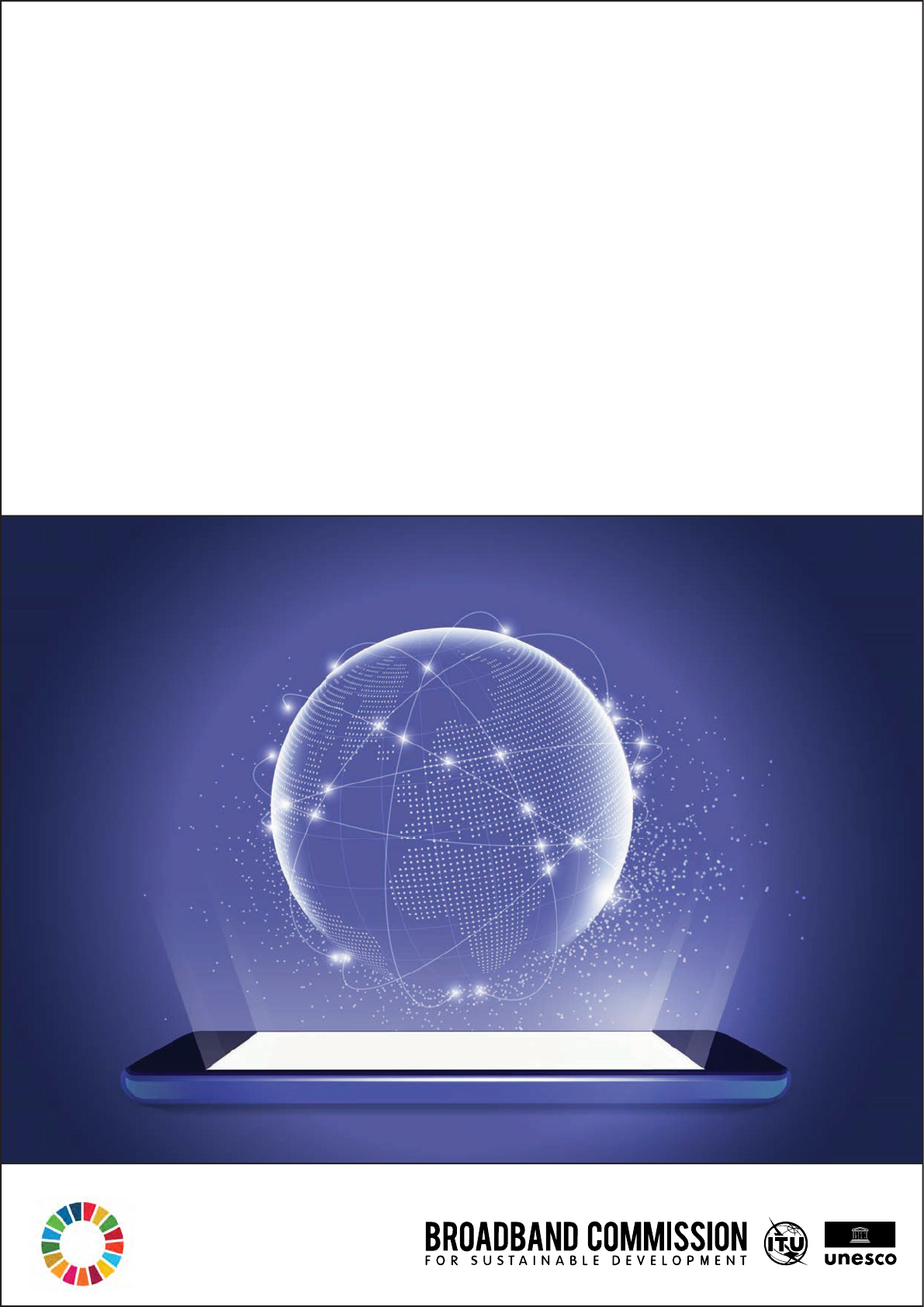
Working Group Report on Smartphone Access
Strategies Towards Universal
Smartphone Access
September 2022

Working Group Report on
Smartphone Access
Strategies Towards
Universal Smartphone Access
September 2022

iv
Acknowledgements
This report and its recommendations are a
collective endeavour drawing on contributions
and insights from the participants of the
ITU/UNESCO Broadband Commission for
Sustainable Development’s Working Group on
Smartphone Access.
The Working Group on Smartphone Access
was co-chaired by Nick Read, CEO of Vodafone
Group, Houlin Zhao, Secretary General of the
International Telecommunication Union and
Rabab Fatima, UN High Representative for
the Least Developed Countries, Landlocked
Developing Countries and Small Island
Developing States (UN-OHRLLS).
The Working Group Co-Chairs greatly and
sincerely appreciate the efforts of our Working
Group members and external experts for their
invaluable contributions, kind review, and
useful comments and feedback. The Working
Group members and experts are listed below.
This report has been informed by research
from GSMA, ITU and 19 structured expert
interviews, as well as insights from International
Trade Centre (ITC) convened focus group of
entrepreneurs (listed below) and extensive
desk research. We gratefully acknowledge all
for sharing their time and expertise to develop
the report and we extend our sincere gratitude
to H.E. Emma Inamutila Theofelus, Deputy
Minister of Information and Communication
Technology, Republic of Namibia, for sharing
her views and perspective on the topic.
We would like to acknowledge with much
appreciation the crucial role of Professor
Christopher Yoo, John H. Chestnut Professor
of Law, Communication, and Computer
& Information Science at the University of
Pennsylvania, the Working Group expert
as well as lead author of the report, and his
team at University of Pennsylvania – Dr. Leon
Gwaka, Sindhura Kammardi Sachidananda,
Sophie Roling, Shahana Banerjee, and Meghan
Moran – for conducting extensive research and
drafting this comprehensive report.
In addition, we would like to thank the following
for executing the work of the Working Group
and providing invaluable subject matter
knowledge and guidance throughout the
process: Doreen Bogdan-Martin, Alex Wong,
Nancy Sundberg, Anna Polomska, Sameer
Sharma, Karen Woo, Julia Gorlovetskaya and
Leah Mann from ITU. Heidi Schroderus-Fox,
Miniva Chibuye and Conor O’Loughlin from
UN-OHRLLS. Davide Tacchino and Kefilwe
Madingoane from Vodacom. Joakim Reiter,
Bobbie Mellor, Joe Griffin and Maleeha Khan
from Vodafone Group.
Working Group Members: Commissioners
and Focal Points
• America Móvil: Commissioner Dr. Carlos
Jarque
• Benin: Commissioner H.E. Aurélie Adam-
Soule Zoumarou and Bleck Yoro
• FAO: Commissioner Dr. Qu Dongyu,
Maximo Torero Cullen and Henry
Burgsteden
• Ghana: Commissioner H.E. Ursula Owusu-
Ekufu, Afua Mensah and Kwame Baah-
Acheamfuor
• GSMA: Commissioner Mr. Mats Granryd ,
Belinda Exelby and Luca Elmosi
• ITC: Commissioner Ms. Pamela Coke-
Hamilton, James Howe, Riefqah Jappie and
John Ndabarasa
• Intelsat: Former Commissioner Mr. Stephen
Spengler and Jose Toscano
• International Science Technology and
Innovation Centre for South-South
Cooperation: Commissioner Dato’ Lee Yee
Cheong
• Millicom: Commissioner Mr. Mauricio
Ramos, Aidan McCartan, Horacio Romanelli
and Karim Lesina
• Smart Africa: Commissioner Mr. Lacina
Koné, Thelma Efua Quaye, Osman Issah,
Calvain Nangue and Wilgon Tsib
• UNESCO: Co-Vice Chair of the
Commission, Ms. Audrey Azoulay and
Borhene Chakroun
Strategies Towards Universal Smartphone Access

v
• ZTE: Commissioner Mr. Ziyang Xu, Lei Xue
and Tian Dao
External Experts
• Alliance for Affordable Internet (A4AI):
Sonia Jorge and Teddy Woodhouse
• ARM: Neil Fletcher
• AST: Clemens Wolbers and Chris Ivory
• Google: Mariam Abdullahi, Vinod Nenwani
and Aleksandra Stremidlo
• HMD/Nokia: Alain Lejeune, Won Chang,
Florian Seiche and Justin Maier
• Intel: John M Roman and Turhan Muluk
• Mara Phone: Ashish J. Thakkar and Eddy
Sebera K.
• PayJoy: Deepak Murthy and Dominique
Friedl
• Softbank: Jingyi Huang, Osamu Kamimura
and Masumi Oyama
• TCT: Aaron Zhang, Ernst Wittmann and
Guoqing Yao
• Transsion: Steven Huang and Yoyo Zhang
• Trustonic: Dion Price and Craige Fleischer
• World Bank Digital Development Global
Practice: Doyle Gallegos
ITC-convened Focus Group
• Aspira (Kenya): Irshad Muttur
• FollowMeTalk (Kenya): Edwin Okoye
• Intelligra (Nigeria): Tayo Ogundipe
• Kei Phone (Uganda): Maria Nampijja
• Lipalater (Uganda): Ephraim Okalebo
• Nuovo Pay (Nigeria): Nitesh Bhalothia
• PayJoy (Nigeria): Dominique Friedl
• Superfluid (Ghana): Winifred Kotin
Disclaimer
This research report, titled Strategies Towards Universal Smartphone Access is based on data and
material accessible as of 31 Aug 2022 and may not reflect circumstances thereafter.
This report has been prepared, with the support of experts under the supervision of Professor
Christopher Yoo, John H. Chestnut Professor of Law, Communication, and Computer & Information
Science at the University of Pennsylvania, andthe members of the Broadband Commission Working
Group on Smartphone Access co-chaired by Nick Read, CEO Vodafone Group; Houlin Zhao,
Secretary General of the International Telecommunication Union and Rabab Fatima, UN High
Representative for the Least Developed Countries, Landlocked Developing Countries and Small
Island Developing States.
The ideas and opinions expressed in this publication do not necessarily reflect the views of the
Broadband Commission members or their organizations. This Working Group report does not
commit the Broadband Commission for Sustainable Development.
Strategies Towards Universal Smartphone Access

vi
Strategies Towards Universal Smartphone Access
Acknowledgements ��������������������������������������������������������������������������������������������������������������������������������������� iv
Vodafone Group foreword
�������������������������������������������������������������������������������������������������������������������������� viii
ITU foreword
���������������������������������������������������������������������������������������������������������������������������������������������������ix
UN-OHRLLS foreword
�������������������������������������������������������������������������������������������������������������������������������������x
Executive summary
����������������������������������������������������������������������������������������������������������������������������������������xi
Section 1: Introduction: The opportunity
����������������������������������������������������������������������������������������������������� 1
1.1 The benefits of Internet connectivity ................................................................................................1
1.2 Shifting focus from the “coverage gap” to the “adoption gap” ....................................................2
1.3 The “consumption gap” as the next frontier and the benefits of upgrading to
smartphones and broadband ............................................................................................................3
1.4 Mobile Internet access for sector-specific use cases ......................................................................5
Section 2: Smartphone access as a barrier to adoption
������������������������������������������������������������������������� 10
2.1 Supply-side barriers ..........................................................................................................................12
2.1.1 Supply-side barrier – handset affordability .......................................................................12
2.1.2 Supply-side barrier – last-mile supply chain issues..........................................................14
2.1.3 Supply-side barrier – foreign currency availability and exchange rate volatility .........14
2.2 Demand-side barriers .......................................................................................................................14
2.2.1 Demand-side barrier – lack of consumer understanding and information .................14
2.2.2 Demand-side barrier – lack of sufficient incentives .........................................................15
2.2.3 Demand-side barrier – digital illiteracy .............................................................................15
2.2.4 Demand-side barrier – social and cultural norms ............................................................15
2.2.5 Demand-side barrier – security and harassment .............................................................16
Section 3: Case studies and evaluation
����������������������������������������������������������������������������������������������������� 20
3.1 Methodology ......................................................................................................................................20
3.2 Higher priority interventions ............................................................................................................20
3.2.1 Higher priority intervention – device financing ................................................................20
3.2.2 Higher priority intervention – taxes and import duties ...................................................26
3.2.3 Higher priority intervention - improved distribution channels ......................................31
3.3 Interventions that merit further exploration ...................................................................................34
3.3.1 Intervention for further exploration - device subsidies ...................................................34
3.3.2 Interventions for further exploration – reuse of preowned smartphones ....................39
3.4 Lower priority interventions .............................................................................................................43
3.4.1 Lower priority intervention – local manufacturing ...........................................................43
3.4.2 Lower priority intervention – smart feature phones ........................................................47
Table of contents

vii
Section 4: Translating our findings into action: A five-point plan to increase smartphone
ownership ............................................................................................................................................... 53
Conclusion..................................................................................................................................................... 56
List of figures and tables
Figures
Figure 1: Mobile Internet (MI) connectedness, adoption gap, and coverage gap by region, 2020
.........................................................................................................................................................3
Figure 2: 4G connectedness, adoption gap, and coverage gap by region, 2019....................................5
Figure 3: Main reason for not using the mobile Internet, 2019-20 ...........................................................10
Figure 4: Main reason for not having a smartphone, 2017-18 ...................................................................11
Tables
Table 1: Classification of case study interventions .......................................................................................20
Strategies Towards Universal Smartphone Access

viii
Vodafone Group foreword
Over the last ten years, our daily lives, societies and economies have been transformed by
highspeed connectivity and smartphones. We can now keep in touch with loved ones wherever they
are. We can access key health, education and government services remotely. Entrepreneurs and
small businesses can become connected and flourish. And we can entertain ourselves 24/7. Digital
connectivity is now a necessity, no longer a luxury.
Now, as much of the world stands on the edge of a 5G revolution with the potential to address
some of our biggest challenges, there are still 2.7 billion people who remain on the other side of the
digital divide, unconnected. Most of these people live in Low and Middle Income Countries (LMICs),
and most are covered by a mobile broadband network.
One of the biggest barriers to access is affordable smartphones. In many LMICs they can cost over
70% of the average monthly income. However, we lacked a collaborative action plan to overcome
this barrier to connectivity. That is why in 2021 we launched the Broadband Commission’s Working
Group on Smartphone Access. This is the first ever cross-industry and government group on
affordable access to smartphones, and a continuation of Vodafone’s commitment to closing the
digital divide through our Africa.connected programme.
Over recent months, the group has studied the biggest barriers to smartphone access, and tested
initiatives designed to improve access, with the aim of producing clear recommendations to policy
makers, industry and international organisations. This report is the culmination of those efforts.
We know that if we solve the problem of global smartphone access, the benefits will be enormous.
According to the World Economic Forum, a 10% increase in access to mobile broadband would
lead to an average 1.5% increase in GDP. In Africa, the increase would be 2.5%. For the individual,
the impact is also lifechanging. Studies show that mobile Internet adoption is linked to a 3% rise in
socioeconomic wellbeing. We also know that efforts to close the digital divide must not come at the
cost of the planet, and we have explored interventions that may concurrently address growing levels
of e-waste.
This report recommends a five point action plan to increase smartphone ownership for all. It's
important that we now agree on continued cooperation to translate this action plan into positive
outcomes.
I would like to thank every member of the Working Group for the energy, expertise and insight they
contributed to this report. I look forward to working with governments, international organisations,
and other technology companies to make the recommendations of this report a reality.
Vodafone’s purpose is to connect for a better future by using technology to improve lives, digitalise
critical sectors, and enable inclusive and sustainable digital societies. To achieve this, we cannot
- and must not - leave anyone behind. By acting on the recommendations of the report, we can
ensure that is the case.
Nick Read
CEO Vodafone Group
Strategies Towards Universal Smartphone Access

ix
ITU foreword
It is with great pleasure that the International Telecommunication Union (ITU) presents this
Broadband Commission Working Group Report as a contribution towards promoting universal and
meaningful connectivity against the backdrop of a pandemic-impacted world with growing digital
inequalities.
Since it was founded in 1865, the ITU has contributed to connecting people globally with our role in
managing radio-frequency spectrum and satellite orbit resources, developing technical standards
to ensure interoperability and interconnection of networks and technologies, as well as promoting
connectivity and access to information and communication technologies (ICTs) to underserved and
unserved communities worldwide.
There have been tremendous strides in terms of connectivity, however, as at 2022, ITU estimates that
there are still 2.7 billion people worldwide who do not use the Internet. This is despite the fact that
at least 95 per cent of the world’s population live within the range of mobile broadband network.
According to the ITU Global Connectivity Report 2022, affordability and connectivity go hand in
hand. In countries where broadband is affordable, this leads to a high number of Internet users;
conversely, in countries where broadband is not affordable, there exists a high percentage of users
who are unconnected. Further, the lower the share of Internet users in a country, the less affordable
the devices are. In addition, the least mature ICT regulatory environment also goes hand in hand
with the least affordable prices in countries.
In recognizing that affordability is a key element of achieving universal connectivity, the Broadband
Commission for Sustainable Development has set the target to reduce the price of entry-level
fixed or mobile broadband services in low- and middle-income countries to less than 2 per cent of
monthly Gross National Income (GNI) per capita by 2025.
In this regard, the Broadband Commission Working Group on Smartphone Access was established
in November 2021 to address the device gap in order to enhance affordability and digital inclusion.
Co-chaired by Vodafone, ITU, and UN-OHRLLS, this group brings together members from the
Broadband Commission and external experts to examine the barriers to smartphone access and to
explore initiatives to overcome these barriers.
Thanks to the collaborative efforts of all members of the Working Group and their valuable input,
commitment and contributions, this report moves the conversation forward by providing detailed
case studies on initiatives implemented globally to address the challenges in providing affordable
broadband and smartphone access. This report is just the first step. For the next phase, I would like
to invite you to join us to implement the recommended initiatives and the five-point action plan to
reduce the device gap for the underserved communities globally, as we move towards building a
more inclusive, equitable and sustainable world.
Achieving universal and meaningful connectivity and the Sustainable Development Goals (SDGs)
requires a multistakeholder approach, and national, regional, and global collaboration on an
unprecedented scale. We invite you all to join the Broadband Commission to implement the
recommendations to address affordability, reduce the smartphone device gap and enable digital
inclusion. Our goal is to leave no one behind.
Houlin Zhao
Secretary General of the International Telecommunication Union
Strategies Towards Universal Smartphone Access

x
UN-OHRLLS foreword
For many of us – the lucky ones – the mobile phone in our hand is a link to friends and colleagues,
a first line of defence in an emergency, and a tool of research. And yet, billions of people remain
without this most fundamental form of connection. This denies whole communities economic,
educational, and social opportunities, and it holds back the earning power of less developed
nations.
The situation is most acute in the world’s most vulnerable countries – the Least Developed Countries,
Landlocked Developing Countries, and Small Island Developing States – where most of the 2.7
billion people without Internet access live. And within these countries and communities, it is often
the people already at the margins, especially women, who struggle to get online.
Indeed, this report shows that women in low- and middle-income countries are 18% less likely than
men to own a smartphone. This exclusion is worse in the least developed countries, especially in the
most rural areas, and it reinforces and exacerbates their marginalisation.
Smartphone exclusion also acts as a significant brake on growth: a strong correlation exists between
access to mobile Internet services and GDP, with studies showing that as little as a 10% access
increase in 3G services or higher can deliver as much as a 2.46% growth in GDP in low- and middle-
income countries in Africa, and 2.44% in Asia-Pacific.
Infrastructure challenges remain, but this is a crisis of adoption, not connectivity. Mobile coverage is
widely available, but Internet uptake and usage remain low. This report proposes a plan to bridge
that digital divide with clear recommendations based on evidence and lived experience.
In the short term, governments should reduce tax and duties on devices to reflect their growing
centrality to developing economies and telecom operators should introduce more flexible
financing and improved distribution focusing on the most marginalised, especially women and rural
communities.
And in the long term, tackling value chain issues, and greatly improving device recycling, can close
the Internet adoption gap. Like a new train with no passengers, there is little benefit from increasing
Internet coverage without adoption and access.
This is the first time a report of this kind has presented new strategies for universal smartphone
access, and I want to thank my co-chairs from ITU and Vodafone for their leadership and vision,
as well as the rest of the working group for their guidance and expertise. And to the Broadband
Commission, under whose leadership this work has been commissioned, I offer my unwavering
support and that of my office to support the delivery of the solutions proposed herein.
For individuals, institutions and nations alike, the benefits are clear; universal smartphone access can
change lives, bridge divides, and boost economies. We must share these benefits and opportunities
with all.
Rabab Fatima
UN High Representative for the Least Developed Countries,
Landlocked Developing Countries and Small Island Developing States
Strategies Towards Universal Smartphone Access

xi
Executive summary
An estimated 2.7 billion people globally remain offline today. Most of these people are in low- and
middle-income countries (LMICs), and most of them live within good Internet coverage. However,
the cost of a smartphone to access the Internet can exceed 70% of the average income in LMICs,
presenting a significant barrier to digital inclusion.
The adoption gap for mobile Internet – which arises when people do not use the Internet even when
there is mobile network coverage available – is now over seven times larger than the coverage gap
globally.
Furthermore, most people in LMICs who do access the Internet are still using 2G and 3G, which
is preventing them from realizing the full social and economic benefits of high-speed Internet
connectivity.
This study represents the first multi-stakeholder dialogue and analysis on the topic of smartphone
access, under the ITU/UNESCO Broadband Commission for Sustainable Development.
This report examines the barriers to smartphone ownership and usage, and provides
recommendations based on empirical evidence to overcome those barriers, with a special focus
on LMICs. The report categorises the assessed interventions into; “High Priority” interventions,
interventions that “Warrant Further Investigation”, and “Low Priority” interventions. These findings
have been informed by research from GSMA, ITU and 19 structured expert interviews, as well as
insights from an ITC-convened focus group of entrepreneurs, and extensive desk research.
The report’s actionable recommendations are designed to guide stakeholders when determining
how to address smartphone access challenges, and provide a clear roadmap forward.
Key findings
The research found three high priority interventions that are proven to increase smartphone
ownership:
1. Smartphone financing schemes
2. Reduction of taxes and import duties on smartphones
3. Improvement of smartphone distribution channels
We also found two interventions that warrant further investigation:
1. Device subsidies
2. Increasing use of refurbished/preowned devices
Two interventions studied were classified as low priority, meaning that they lacked evidence of
increasing smartphone ownership at scale, but may achieve results at a smaller scale in some
countries:
1. Local manufacturing
2. Supply of smart feature phones
Strategies Towards Universal Smartphone Access

xii
Translating our findings into action: a five-point plan to increase smartphone ownership
This report has been created as a starting point for policymakers, governments, and businesses
to take action on increasing smartphone access. As such, the report provides a five-point action
plan to translate the findings into action, outlined below. Most of the actions require cross-party
collaboration and, as such, the report recommends the establishment of taskforces to drive concrete
commitments, conduct further research, and implement pilots.
Action 1: Initiate win-win partnerships with players across the digital value
chain
Action 2: Improve regulation on smartphone recycling and develop quality
standards for preowned smartphones
Action 3: Develop strategies for recycling of mid- and lower-tier devices
Action 4: Explore the use of Universal Service Funds and other government
subsidies for smartphones
Action 5: Further explore the overall economic benefits of reducing tax and
import duties on smartphones
Strategies Towards Universal Smartphone Access

1
1
Introduction:
The opportunity

1
Section 1: Introduction: The opportunity
1�1 The benefits of Internet
connectivity
Photo credit: ©Asian Development Bank
The policy debate over the global digital
divide and digital equity is undergoing a
fundamental transformation. A growing body
of empirical research has demonstrated the
economic and social benefits of connecting
people.
1
Any remaining doubts were effectively
laid to rest by the COVID-19 pandemic,
which eloquently demonstrated the key role
that Internet access plays in critical areas
such as agriculture, education, health care,
remote working, economic development,
public services delivery, financial services,
and disaster recovery. A recent International
Telecommunication Union (ITU) study estimates
that the number of Internet users surged by
800 million people in 2020.
2
That study also
estimates that 97% of the world population
now has access to a mobile cellular data
network, and that 95% has access to at least
a 3G signal, and the quality of broadband
has also improved with 4G network coverage
doubling between 2015 and 2021 to reach
88% of the world’s population. Mobile phones
continue to be the primary way, and in many
cases, the only way, most people access the
Internet, particularly in low- and middle-income
countries (LMICs).
3
Wi-Fi is also a standard
feature of smartphones that people use to
access the Internet in homes, public hotspots,
and community centres.
Despite these gains, in 2022, an estimated
2.7 billion people still cannot or do not access
the Internet.
4
Furthermore, most of those still
offline live in fragile and conflict-affected areas,
least developed countries (LDCs), landlocked
developing countries (LLDCs) and small
island developing states (SIDS). By way of
comparison, 92% of residents in high-income
country populations are Internet users, while
adoption rates in SIDS (66%), LLDCs (36%),
and LDCs (36%) continue to lag far behind.
5
Research has also shown that overcoming the
barriers to mobile Internet adoption would
yield substantial benefits. Studies conducted
at a national or similarly large-scale level
consistently found that Internet adoption has a
positive impact on national GDP. For example,
the ITU estimates that a 10% increase in fixed
broadband adoption yields a 1.4% increase in
GDP in Europe, 1.9% in the Americas, and 2.5%
in Africa.
6
Other studies have corroborated
these findings:
•
A Broadband Commission study of
Rwanda, Senegal, and Vanuatu from
2010-16 estimates that the information and
communications sector contributed to a
0.3% to 0.5% increase in GDP.
7
• A study of 220 towns in 10 sub-Saharan
African countries employing a new
methodology that uses satellite images of
night-time lights as a proxy for changes
in economic activities estimates that basic
Internet coverage leads to a 2% increase in
economic growth rates.
8
Studies of benefits to individual wellbeing are
beginning to emerge as well.
9
, For example,
surveys of individual users conducted in
Bangladesh and Ghana in 2020 found that
mobile Internet adoption is associated with
a 3% increase in individual socioeconomic
wellbeing, with the effect being larger among
women (4% to 6%) and those with at least
a primary education (5%).
10
Wellbeing is
enhanced by broader access to financial
services, e-commerce, and government
Strategies Towards Universal Smartphone Access
Section 1

2
services.
11
Other studies have found that
Internet access increases women’s participation
in society as well as their social and economic
resilience.
12
Due to COVID-19 and its consequent
lockdowns and social distancing measures,
people relied on their mobile networks to stay
connected with each other and the rest of
the world. Despite the pandemic’s impact on
the economy and consumer incomes, mobile
adoption continued to increase in 2020,
justifying the mobile industry’s contribution
to the UN Sustainable Development Goals
(SDGs). Some contributions to SDGs included
increased use of mobile financial services,
access to government services, and online
learning.
13
Mobile Internet connectivity also creates
benefits during natural disasters both in terms
of sending early-warning alerts to people and
allowing them to share information about
the disaster with authorities.
14
Furthermore,
mobile devices improve coordination and
rescue efforts by enabling rescue teams to
communicate and access key information such
as visuals required for planning.
15
Access to
the Internet is particularly beneficial to women
faced with natural disasters or other threats
that force them to become refugees.
16
During
disasters, vulnerable groups, including persons
with disabilities, can use new technologies to
share their location and improve their chances
of receiving assistance. Applications such as
Facebook Disaster Maps help rescue teams
and victims to establish their location during
disasters.
17
Similar applications and other technologies
are being used to collect data essential for
reviews of disasters.
18
Given the importance
of technologies before, during, and after
disasters, equitable access and use of
technologies, especially among women,
is therefore important.
19
Next generation
technologies, including smartphones and
4G/5G, promise improved approaches and
coordination before, during, and after the
disaster.
20
For example, Google’s earthquake
detection and alert application for smartphones
can help people to prepare before disaster
strikes.
21
Governments can also derive several benefits
from increased access to smartphones among
the citizens. Research shows that smartphones
enhance opportunities for digital government
and citizen engagement. There is evidence that
increased smartphone access enables more
citizens to participate on social media platforms
that have augmented traditional channels to
interact with governments, report concerns,
and provide feedback.
22
In addition, increased
smartphone access also enables sourcing of
open public data that governments can use to
make real time decisions.
1�2 Shifting focus from the “coverage
gap” to the “adoption gap”
Until recently, investments to close the
connectivity gap have focused on rolling
out infrastructure to expand mobile Internet
coverage. These efforts have achieved a
significant degree of success.
The ITU estimates that in 2021, 95% of the
world's population was covered by at least a 3G
signal. Moreover, of the 2.7 billion who remain
offline, only 390 million were not covered by a
mobile Internet 3G signal or better, although
these shortfalls are not evenly distributed.
Specifically, more than 99% of people in
high-income countries have access to mobile
coverage, while only 86% of residents of low-
income countries do.
23
Rural coverage rates lag
behind urban rates as well with respect to basic
mobile cellular coverage (100% for urban areas
vs. 93% for rural areas, for a disparity of 7%),
3G coverage (100% for urban areas vs. 88%
for rural areas, for a disparity of 12%), and 4G
coverage (97% for urban areas vs. 75% for rural
areas, for a disparity of 22%). The urban-rural
disparity is particularly severe in LLDCs (69%),
LDCs (54%), and SIDS (46%).
24
Despite the success in extending mobile
broadband coverage to an ever-increasing
proportion of the world’s population, a large
number of people have access to a network
but remain offline. The significant number
Strategies Towards Universal Smartphone Access
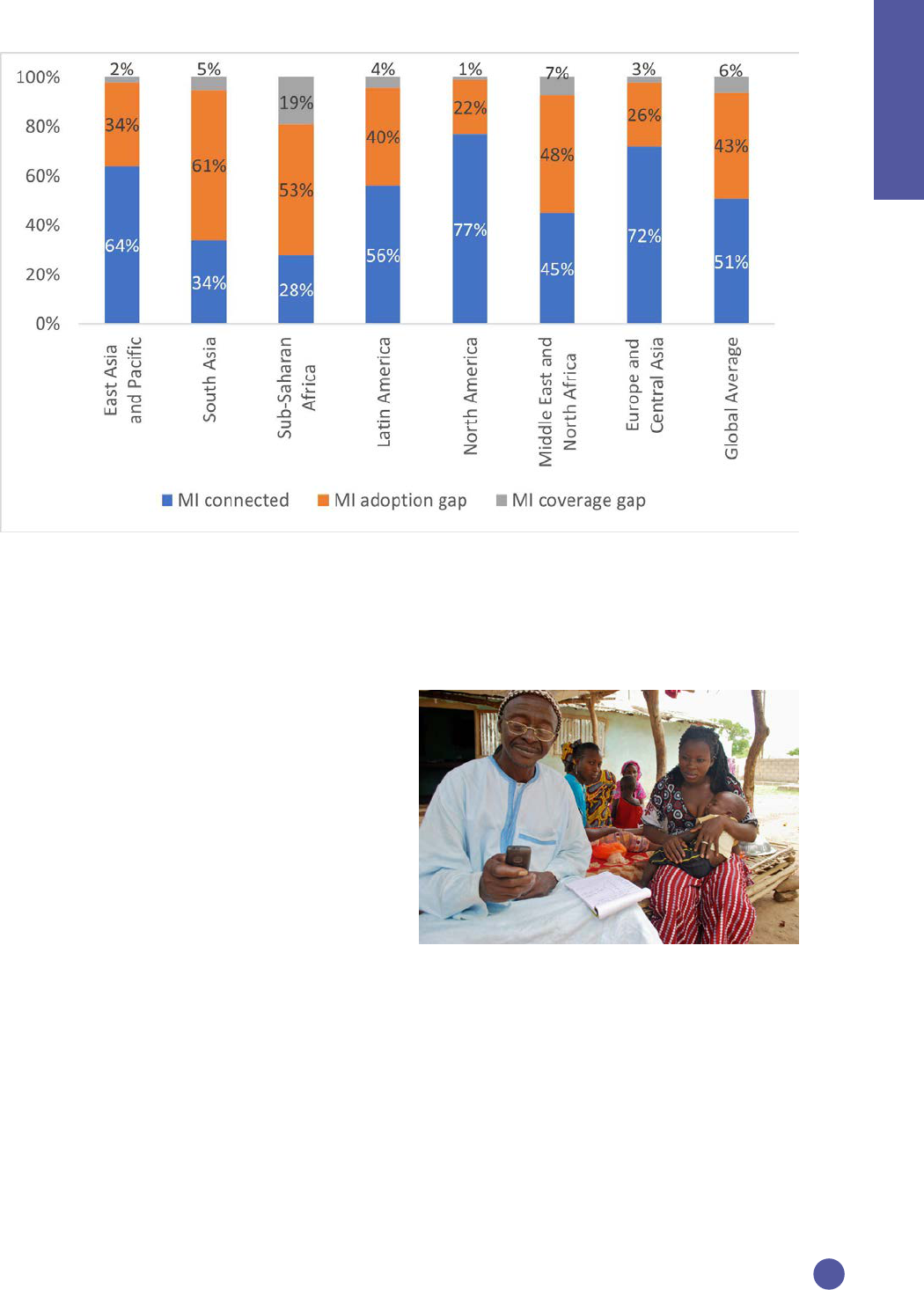
3
of people who have the opportunity to
adopt the Internet but choose not to do so
underscores the need to refocus efforts to close
the digital divide beyond merely expanding
coverage. Policymakers need a more complete
understanding of the barriers to mobile
Internet adoption and how to overcome
them. Studies have increasingly shown that
in addition to “coverage gaps,” the digital
divide is also the product of an “adoption gap,”
which arises when individuals do not use the
Internet even when mobile network coverage
exists.
25
Figure1 shows that the worldwide
adoption gap of 43% is much larger than the
6% coverage gap, with the adoption gaps in
South Asia (61% vs. 5% coverage gap), sub-
Saharan Africa (53% vs. 19% coverage gap),
and the Middle East and North Africa (48% vs.
7% coverage gap) all exceeding the global
average. The size of these adoption gaps
makes clear that significant barriers to adoption
exist aside from coverage.
1�3 The “consumption gap” as the
next frontier and the benefits of
upgrading to smartphones and
broadband
Photo credit: ©OCHA / IRIN
Studies have found that accessing the Internet
through feature phones connected to 2G
networks can enhance economic and social
welfare.
27
However, there are suggestions
that users can gain further benefits by moving
beyond 2G and 3G and connecting to high-
speed broadband services such as 4G and
eventually 5G. For example, a GSMA working
paper studying a panel of 160 countries found
Strategies Towards Universal Smartphone Access
Section 1
Figure 1: Mobile Internet (MI) connectedness, adoption gap, and coverage gap by region,
2020
Source: GSMA
26

4
that upgrading from 2G to 3G increases the
GDP impact of mobile connectivity by 15% and
that upgrading from 2G to 4G increases the
impact by 25%.
28
Analyses that attempted to
identify how broadband connectivity conveys
benefits further underscore the importance of
4G adoption. A World Bank study identified
six foundational online activities—news,
government, health, education, shopping, and
social media—and that realizing the benefits
of these foundational activities requires a
minimum of 6GB per month.
29
A4AI has
emphasized that realizing the benefits of these
more advanced services requires “meaningful
connectivity” that allows individuals to use the
Internet every day using an appropriate device
with enough data and a fast connection.
30
Consistent with this concern, industry observers
have cautioned that the fact that most mobile
Internet users are still using 2G and 3G in most
LMICs is preventing them from realizing the
full benefits of Internet connectivity.
31
Using
education as an example, 2G and 3G support
file sharing only in limited formats, while 4G
and 5G can deliver seamless online interactions
such as video tutorials and interactive learning
exercises.
32
Available data suggest that adoption of mobile
broadband would enable users to access these
services. For example, upgrading users from
2G to 3G increases their data capacity by 9.4
times and data performance by 112 times.
Upgrading users from 3G to 4G increases data
capacity by 4.2 times and data performance by
4.6 times. 5G is expected to deliver higher peak
data speeds, lower latencies, and higher data
capacity. By 2027, 5G subscriptions across the
globe are forecast to reach 4.4 billion, nearly
half of all mobile subscriptions.
33
Studies conducted at the country level have
consistently found that adoption of mobile
broadband services such as 3G, 4G, and 5G
would provide significant economic and social
benefits:
•
An ITU study of 145 countries between
2010-18 found that a 10% increase in
unique subscriber penetration for 3G or
higher services yielded a 1.50% increase
in GDP driven by a 1.76% increase in
middle-income countries and a 1.98%
increase in low-income countries.
34
This
effect was particularly strong in Africa
(2.46% increase), Asia Pacific middle- and
low-income countries (2.44%), European
low-income countries (2.00%), Arab states
(1.82%), and Latin American and Caribbean
states (1.73%).
•
A UN-OHRLLS and ITU study of 91 LDCs,
LLDCs, and SIDS from 2000-17 found that
a 10% increase in 3G, 4G, and WiMAX
penetration generated a 2.8% increase in
GDP.
35
• IHS Markit has predicted that by 2035,
5G will enable USD 13.2 trillion of global
economic output and will represent about
5.0% of all global real output.
36
Studies conducted at the household level
that used consumption as a proxy for income
corroborated these findings:
•
Surveys conducted in Senegal in 2011 and
2017 indicate that household consumption
is 14% higher and that the extreme poverty
rate is 10% lower in areas covered by 3G.
37
• Three rounds of household surveys
conducted in Nigeria between 2010-16
revealed that at least one year of 3G or 4G
mobile broadband coverage increased
household consumption by 6% and
reduced extreme and moderate poverty by
4.3% and 2.6% respectively.
38
• Three rounds of surveys administered in
Tanzania between 2008 to 2013 found that
3G coverage was associated with a 10%
increase in household consumption and
that one year of coverage was associated
with a 3%-8% increase in labour force
participation, wage employment, and non-
farm employment.
39
The benefits from 3G, 4G, and 5G mobile
broadband connectivity appear to have
increased during the COVID-19 pandemic.
For example, a new ITU study that extended
the previous ITU study found that including
2019 and 2020 in the analysis caused the GDP
increase associated with a 10% increase in
mobile broadband penetration to grow from
1.50% to 1.60% worldwide, driven by a 2.04%
increase in GDP in low-income countries and
a 162% increase in GDP growth in middle-
income countries.
40
Strategies Towards Universal Smartphone Access
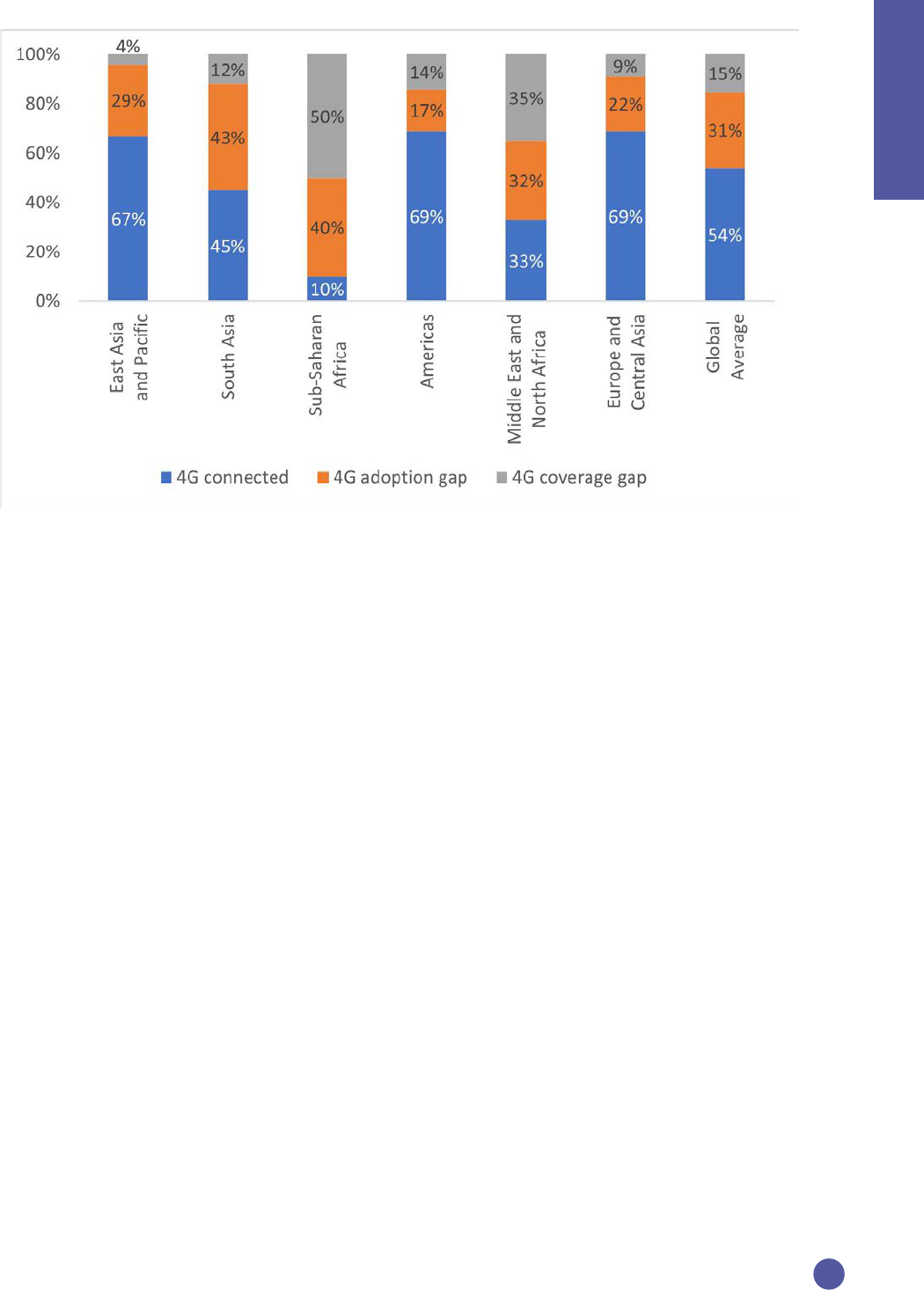
5
Despite the benefits that come from adopting
3G and 4G mobile broadband services,
adoption rates remain low. This problem is
especially prominent in LMICs.
4G adoption similarly continues to lag,
although 4G coverage gaps remain significant
in some areas. The ITU reports a global 4G
adoption gap of 31% vs. a coverage gap of
15%. The adoption gap exceeds the global
average in South Asia (43% vs. 12% coverage
gap) and sub-Saharan Africa (40% vs. 50%
coverage gap), and Middle East and North
Africa (32% vs. 35% coverage gap).
These data suggest that simply closing the
coverage gap (by extending mobile networks
to cover unserved areas) and closing the
adoption gap (by getting people with access
to a mobile signal to subscribe) would not be
enough to ensure that people obtain the full
benefit of Internet connectivity. Policymakers
must also address what the World Bank calls
the “consumption gap,” which arises when
Internet data consumption among people
who have adopted the Internet remains low.
42
Closing the consumption gap will require
interventions beyond those necessary to close
the coverage gap and the adoption gap.
Beyond providing simple network connectivity
and a device capable of connecting to the
mobile Internet, enabling people to use the
full capabilities that the Internet has to offer
requires extending higher level connectivity
(4G and 5G) and expanding access to higher
level devices such as smartphones.
1�4 Mobile Internet access for sector-
specific use cases
In addition to individual level use of
connectivity, research shows the importance
of the mobile Internet at an institutional level.
Mobile Internet is reported to support activities
in agricultural, educational, and health-
care institutions. However, use patterns and
mechanisms are likely to vary across sectors.
43
The different use patterns result in demands
for different levels of connectivity and devices
across different institutions. For example,
schools need more devices and power than
clinics, with a typical school needing at least
one device per every two students. In contrast,
a clinic, depending on its size, could get by
with a few devices at crucial points of care for
Strategies Towards Universal Smartphone Access
Section 1
Figure 2: 4G connectedness, adoption gap, and coverage gap by region, 2019
Source: ITU
41

6
registering patients, consulting patients, and
managing medicines.
44
The fact that this Working Group’s charter
focusses on smartphone access inevitably drew
attention away from issues surrounding access
to laptops, tablets, and other similar devices.
The relative lack of attention on other types
of devices in this report reflects that no study
can address every aspect of every issue and is
not meant to suggest that that such issues are
unimportant.
Strategies Towards Universal Smartphone Access
Photo credit: ©Asian Development Bank

7
1
Hjort and Tian: The Economic Impact of Internet Connectivity in Developing Countries; Vergara-Cobos and
Malásquez: Digital Technology Adoption and the Jobs and Economic Transformation Agenda: A Survey;
ITU: The State of Broadband 2021.
2
ITU: Measuring Digital Development: Facts and Figures 2021.
3
GSMA: The State of Mobile Internet Connectivity 2021; ITU: Connect2Recover: A new methodology for
identifying connectivity gaps and strengthening resilience in the new normal.
4
ITU: Measuring digital development: Facts and Figures 2022 (forthcoming).
5
ITU: Measuring digital development: Facts and Figures 2022 (forthcoming).
6
ITU: How broadband, digitization and ICT regulation impact the global economy: Global econometric
modelling.
7
Broadband Commission for Sustainable Development: Working Group on Broadband for the most
vulnerable countries.
8
Min et al.: Light every night – New nighttime light data set and tools for development; Goldbeck and
Lindlacher: Digital infrastructure and local economic growth: early Internet in Sub-Saharan Africa.
9
A4AI: The costs of exclusion: South Asia regional report; GSMA: The impact of mobile on people’s
happiness and well-being.
10
Yoo et al.: Exploring the Deep Structure of Mobile Internet Use Patterns in Bangladesh and Ghana
(Unpublished Report, University of Pennsylvania).
11
ITU: Connectivity in the least developed countries: Status report 2021; GSMA: 2021 mobile industry impact
report: Sustainable development goals.
12
A4Ai: The costs of exclusion: South Asia reginal report; A4AI: The costs of exclusion: West Africa regional
report.
13
GSMA: 2021 mobile industry SDG impact report.
14
ITU: Women, ICT and emergency telecommunications: opportunities and constraints; ITU: Utilizing
telecommunications/information and communication technologies for disaster risk reduction and
management.
15
Rawat et al.: Towards efficient disaster management: 5G and device to device communication.
16
Mallalieu: Women, ICT, and emergency telecommunications: opportunities and constraints.
17
ITU: Utilizing telecommunications/information and communication technologies for disaster risk reduction
and management.
18
ITU: Utilizing telecommunications/information and communication technologies for disaster risk reduction
and management.
19
ITU: Women, ICT and emergency telecommunications: opportunities and constraints.
20
Rawat et al.: Towards efficient disaster management: 5G and device to device communication.
21
Google: Earthquake detection and early alerts, now on your Android phone.
22
Republic of Kenya: Kenya digital economy. Digital economy blueprint – powering Kenya’s transformation
23
ITU: Measuring digital development: Facts and figures 2021.
24
ITU: ITU world telecommunication/ICT indicators database.
25
ITU: The State of Broadband: People-Centered Approaches for Universal Broadband.
26
GSMA: Accelerating mobile Internet adoption: Policy considerations to bridge the digital divide in low- and
middle-income countries. The data from GSMA is based on 2020, and note there is difference with ITU data
in 2021 and 2022 cited in the report.
27
Mensah, J. T: Mobile phones and local economic development: A global evidence.
28
GSMA Intelligence: Mobile technology: Two decades driving economic growth.
29
Chen and Minges: Minimum data consumption: How much is needed to support online activities, and is it
affordable?.
30
A4AI: Advancing meaningful connectivity: Towards active & participatory digital societies.
31
GSMA: Closing the coverage gap: How innovation can drive rural connectivity; Vodafone: Next-generation
mobile connectivity.
32
GSMA: The WRC series Study on socio-economic benefits of 5G Services provided in mmWave Bands.
33
Ericsson: Ericsson Mobility Report 2021.
Strategies Towards Universal Smartphone Access
Endnotes

8
34
ITU: How broadband, digitization and ICT regulation impact the global economy: Global econometric
modelling.
35
ITU and UN-OHRLLS: Economic impact of broadband in LDCs, LLDCs and SIDS: An empirical study.
36
IHS Markit: The 5G economy: How 5G will contribute to the global economy.
37
Masaki et al.: Broadband Internet and household welfare in Senegal.
38
Bahia et al.: The welfare effects of mobile broadband Internet: Evidence from Nigeria.
39
Bahia et al.: Mobile broadband Internet, poverty, and labor outcomes in Tanzania.
40
ITU: How broadband, digitization and ICT regulation impact the global economy: Global econometric
modelling; ITU: The economic impact of broadband and digitization through the COVID-19 pandemic:
Econometric modelling.
41
ITU: Connecting humanity: Assessing investment needs of connecting humanity to the Internet by 2030.
42
World Bank: World Development Report 2021.
43
Economist Intelligence Unit: Bridging the digital divide to engage students in higher education.
44
Lane: Smart Business Models Are Needed to Connect Schools & Clinics.
Strategies Towards Universal Smartphone Access

1
2
Smartphone access
as a barrier to
adoption

10
Section 2: Smartphone access as a barrier to
adoption
The fact that many people do not adopt
mobile broadband even when it is available
underscores that closing the digital divide is not
simply a matter of extending network coverage.
Policymakers wishing for their people to realize
the benefits of Internet connectivity must
understand the other potential barriers to
adoption.
A study conducted of mobile users who do not
use mobile Internet in 15 countries in 2019-20
found that lack of access to devices was the
second-most frequently cited reason for not
using the Internet (Figure3).
This insight was confirmed by a World Bank
phone survey of 22 Latin American countries
conducted in June-July 2021, which found that
lack of access to a network signal was only the
third-most cited obstacle to Internet access
(10%), behind the high cost of data (60%) and
device cost (14%), and ahead of the lack of
digital skills (4%).
2
Other studies similarly report
that the adoption gap is the product of several
factors, including affordability of both devices
and data, lack of digital skills, relevance, and
inadequate safety and security, among others.
3
Access to a device thus emerges as one of
the critical barriers that must be overcome
for people to be able to access the Internet.
Enjoying the benefits of higher speed services
such as 4G requires access to not just any
device; it requires access to a smartphone.
Obstacles to smartphone ownership exist
worldwide but are particularly acute in lesser
developed areas of the world. A Pew Research
Centre study that compared smartphone
ownership in 19 advanced economies and
nine emerging economies found that the
percentage of adults owning any kind of mobile
Strategies Towards Universal Smartphone Access
Figure 3: Main reason for not using the mobile Internet, 2019-20
Source: GSMA
1
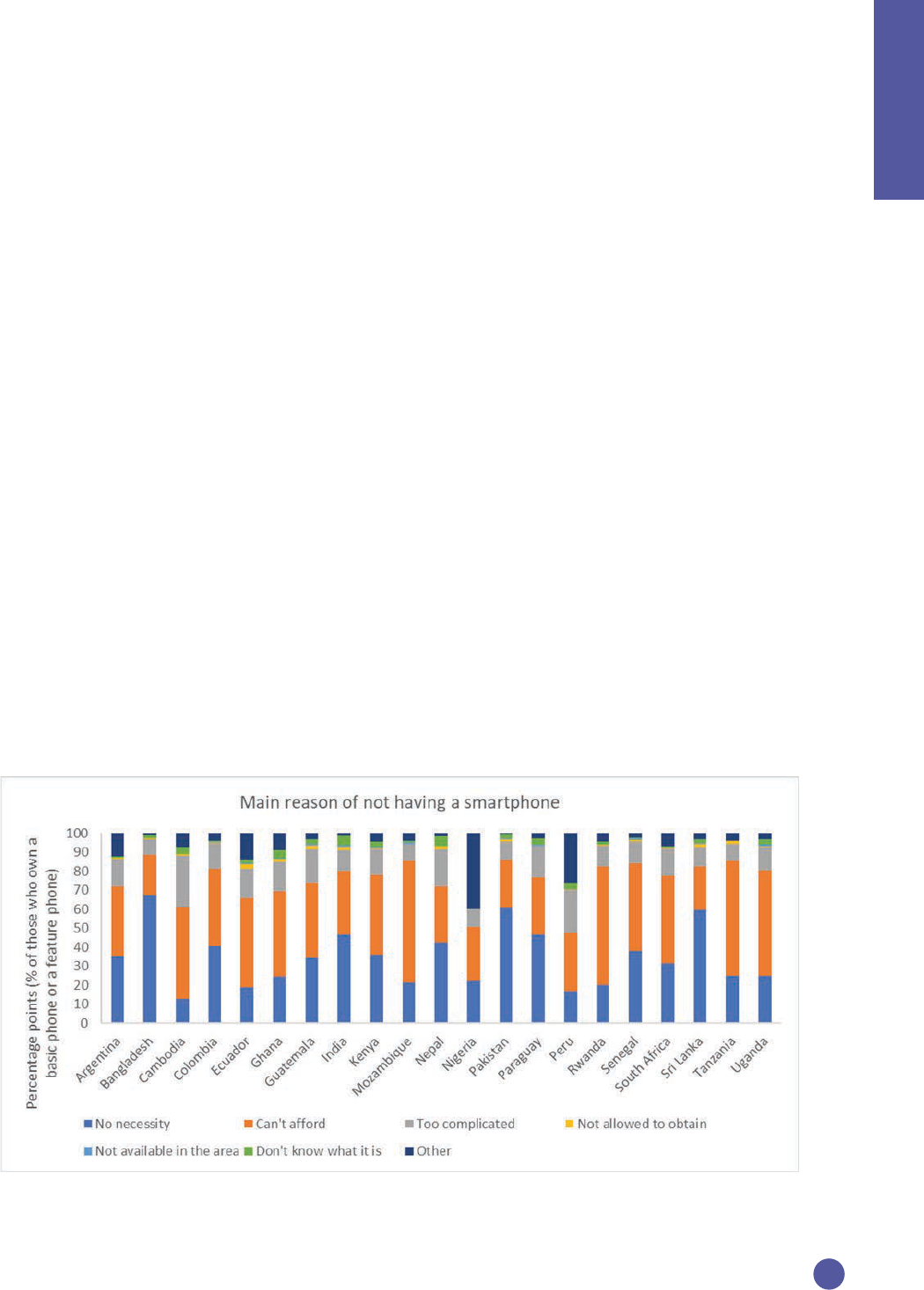
11
phone reached 94% in advanced economies
and 83% in emerging economies.
4
However, in
terms of adults owning a smartphone, the gap
between advanced and emerging economies
widens. At least 76% of adults in advanced
economies own a smartphone compared
to only 45% in emerging economies. As an
example, at the end of June 2019, MTN had
240 million subscribers on its network in Africa
and the Middle East but only 108 million of
these were using smartphones.
5
A World Bank phone survey conducted in
2017-18 among owners of a basic mobile
phone in 22 countries across Africa, Latin
America, and Asia found that the reasons for
not owning a smartphone include affordability
(39%), lack of electricity at home (18%), and lack
of mobile coverage (16%). Moreover, around
70% of phone owners have only a basic or
feature phone, particularly in African countries.
The study also finds that affordability is among
the top three reasons that device owners have
chosen not to obtain a smartphone in every
country surveyed.
6
As shown in Figure 4, many factors contribute
to the lack of access to smartphones. Efforts
to address these challenges have been
hindered by a lack of concrete information
regarding their relative importance and the
effectiveness of interventions to address them.
An extensive review of literature suggests that
a study by GSMA presents one of the more
comprehensive lists of barriers to smartphone
access.
8
This study classifies the barriers to
smartphone access and ownership into four
main categories: income and affordability,
incentives to own and use a smartphone, user
capability and design, and infrastructure.
Understanding barriers to device access is thus
a critical step in making sure that everyone can
enjoy the benefits of Internet connectivity.
In this report, we classify the barriers to
smartphone access into two main categories:
supply-side and demand-side, each with
its own subcategories.
9
Other barriers
to smartphone access, such as device
refurbishment, fall into neither the supply nor
demand-side category. These are discussed
further in the report with the help of existing
literature such as Chen.
10
We also note that
productivity applications in key sectors, such
as agriculture, education, manufacturing, and
health care, may require devices with larger
form factors, such as laptops and tablets.
11
However, several questions remain: For
example, in what context are different devices
relevant? Even when this is answered, there is
Strategies Towards Universal Smartphone Access
Section 2
Figure 4: Main reason for not having a smartphone, 2017-18
Source: Chen
7

12
a need to establish the impact that universal
access to device has across social groups.
2�1 Supply-side barriers
Supply-side barriers are constraints that device
suppliers face when attempting to deliver
affordable devices. These mainly result from
business limitations, such as high operating
costs and legacy business models.
12
These
barriers affect the retail prices for smartphones
and distribution channels respectively.
2�1�1 Supply-side barrier – handset
affordability
Handset affordability is one of the most
important barriers to smartphone access and
ownership.
13
Despite the continued decline in
the cost of Internet-enabled handsets, retail
prices of smartphones vary widely across the
globe, driven by factors such as distribution
costs and taxes.
14
Handset affordability appears to affect women
more than men in many low- and middle-
income countries and is cited as the top barrier
preventing women from owning a mobile
phone.
15
In Pakistan, for example, men were
approximately three times more likely to own a
mobile phone than women.
16
Retail costs of handsets
A GSMA survey on barriers to mobile Internet
use reported that handset cost was the single
most important barrier to using the mobile
Internet.
17
The cost of smartphones remains
high relative to average income, especially in
LMICs. A survey of 187 countries conducted
by A4AI suggests that the retail cost of a
smartphone averages 26% of the average
monthly income across the globe. In the
U.S. and Europe, the cost fell below 5% of
the average monthly income, while in the
low-income countries, it exceeds 70%.
18
As
a result, smartphones are not affordable for
most people in most LMICs. This pushes most
individuals to buy 2G phones, which can cost
between USD 6-10, while 4G smartphones
often cost more than USD40.
An analysis of the handset cost composition
and retail price formation indicates that the
retail cost of a device is determined by a
combination of production costs, logistics
costs, intellectual property rights costs, retailers’
margins, and relevant taxes, such as import
duties and VAT. Research further suggests
that the global technology value chain has
been undergoing significant transformations
in recent years, but the onset of the COVID-19
pandemic exacerbated the already present
tension and created excess demand in
the chipset supply sector.
19
Despite new
innovations, the retail costs of mobile handsets
continue to be influenced by the costs of
hardware and operating systems.
20
Additionally,
the disruption of global and local logistics
caused smartphone prices to rise during the
early days of the pandemic
21
only to see them
fall again in response to oversupply in the face
of softening demand.
22
The spectre of further
lockdowns could cause prices to rise again.
23
High taxes and device import duties on
smartphones
Although taxes and import duties are factored
in the retail prices discussed above, they are
a policy component and warrant a separate
discussion. Evidence from studies such as
GSMA indicates that different governments,
especially in LMICs, have been imposing
sector-specific taxes and import duties on
smartphones that makes them inaccessible
to many.
24
Taxes on smartphones vary from
country to country, and justifications for
imposing import taxes on smartphones include
stimulating local industry. However, in countries
where local industry is non-existent, taxes and
duties on mobile phones are imposed to boost
government revenue.
25
In addition, some governments, especially
in Africa, are levying taxes on smartphones
in a way similar to luxury goods, resulting
in excessively high final prices for devices.
26
Reports in Pakistan indicated a 240% hike in
import duties on mobile phones,
27
while in
Strategies Towards Universal Smartphone Access
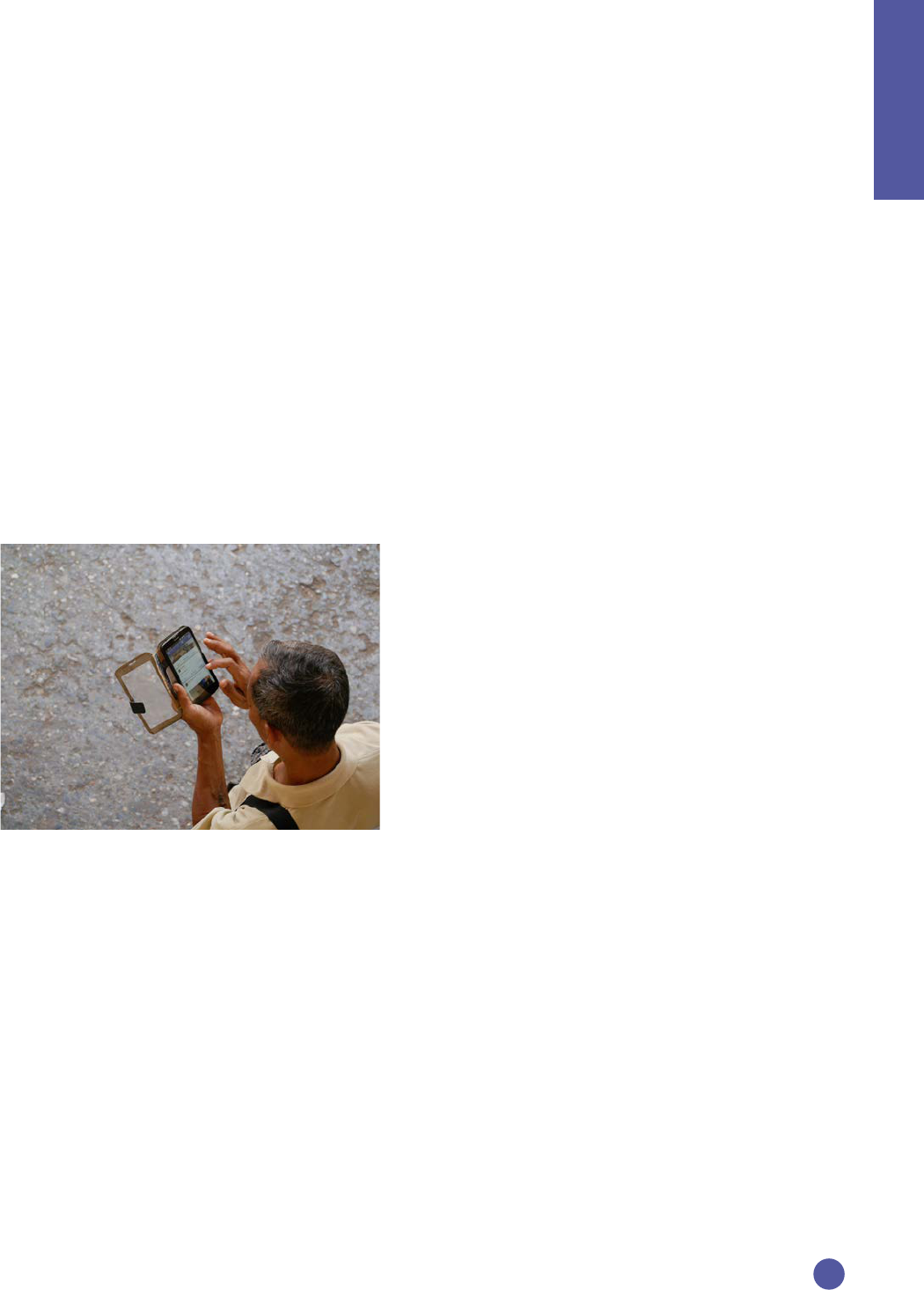
13
Zimbabwe, the Ministry of Finance proposed
a USD 50 levy for the registration of imported
handsets onto a mobile network in addition to
a 25% import tax on mobile handsets.
28
Other
countries have large sector-specific tax rates
and excise duties, including Tanzania, which
charges excise duties on mobile services of
17% of revenue. The sector-specific tax rate
on mobile devices was 18%.
29
Collectively,
taxes and device import duties translate into
high costs of devices which act as a barrier to
smartphone access.
Studies by the OECD and ITU have raised
questions about whether taxes targeting the
digital sector may have adverse distributional
consequences and may dampen the
spillover benefits that the adoption of digital
technologies creates for the entire economy.
30
Other costs affecting handset affordability
Photo credit: ©Asian Development Bank
The total costs of owning a smartphone or
general mobile phone extend beyond solely
the retail price. In the 2017 GSMA report,
additional costs identified include SIM cost,
credit cost, and battery charging costs.
However, the extent to which these costs are
barriers to smartphone access differs across
countries. SIM card costs appear not to be of
concern for participants in Colombia, DRC,
and Indonesia but were reported as a major
barrier in Turkey. At the same time, credit
costs appeared as a moderately universal
barrier in the surveyed countries and one
that disproportionately affects more women.
Niger and Kenya had the most respondents
indicating that cost of battery charging was a
barrier, and likely due to the limited battery
charging infrastructure in those countries.
These additional costs often result in individuals
selecting feature phones, which cost less and
have a reputation of longer battery life and
durability.
31
Unregulated markets
Due to the high cost of smartphones,
distribution channels unauthorized by device
manufacturers have emerged. These are
referred to as parallel or black markets. Devices
sold in these markets are often produced from
components copied from original devices,
resulting in inferior quality devices.
32
Usually,
parallel import flourishes in markets with high
import duties. Markets with high duties tend
to be very inefficient as the duties reduce legal
import significantly, and illegal import then
spikes with the cost and quality issues. Parallel
markets are often used as routes to sell illegally
imported devices, i.e., devices imported
without paying appropriate duties and taxes. In
Nepal, the government’s introduction of a 5%
excise duty on smartphone imports reduced
the legally imported devices while at the same
time fuelling a growth in the black markets for
devices.
33
There are several issues associated with
purchasing smartphones from parallel markets
that can act as barriers to smartphone access.
Most devices purchased from parallel markets
are produced from copied parts that often fail
after a short time in use.
34
Further, these devices
are sold with no warranties or repair options.
35
The non-durability of devices purchased from
parallel markets, the lack of warranties, the
limited repair options, and the risk of phone
data being stolen through invasive software
contribute to the negative perceptions towards
smartphones, thereby acting as a barrier to
smartphone access.
36
Strategies Towards Universal Smartphone Access
Section 2

14
2�1�2 Supply-side barrier – last-mile
supply chain issues
Another barrier to smartphone access is last-
mile supply issues resulting from the challenges
faced by smartphone retailers serving remote
communities and the difficulties they face
making their products visible to populations
in such communities. Rural areas are difficult
to access, making transport and logistics costs
significant.
37
Furthermore, there are fewer
retailers of smartphones in rural areas, which
limits options for customers, limits competition,
and complicates the regulation of retail prices.
38
Most device retailers perceive demand in
remote communities to be low due to poor
mobile networks, resulting in fewer retailers in
these communities. In addition to low demand,
remote locations, especially in LMICs, lack
facilities, such as retail space, where mobile
phone retailers can operate, requiring them to
construct their own units. This further increases
the required initial capital outlay to serve the
remote locations.
Hard-to-reach remote communities are also
often off-grid, which means, apart from the
challenge of accessing devices, individuals
also worry about their ability to recharge their
devices. This issue is compounded by the high
costs of battery charging.
39
Literature highlights
the importance of access to electricity
towards digital inclusion. Studies report that
“households without access to electricity,
on-grid or off-grid, need to rely on more
expensive sources of energy to power their
mobile handsets.
40
Therefore, last-mile supply
chain challenges facing smartphone retailers
and electricity supply companies contribute as
barriers to smartphone access and ownership.
2�1�3 Supply-side barrier – foreign
currency availability and exchange rate
volatility
Lack of access to hard currency and exchange
rate volatility represent other commonly
cited barriers to obtaining smartphones.
For example, in Ethiopia, where device
manufacturer Transsion operates, the currency
allocation rules prioritize sectors such as
pharmaceuticals, which limits the foreign
currency available for procuring devices and
device components.
41
In addition, the fact
that most devices are imported necessarily
means that fluctuations in foreign exchange
rates, especially currency depreciation, present
additional challenges to entities seeking to
market devices in LMICs.
2�2 Demand-side barriers
Demand-side barriers are constraints that
individuals face when trying to obtain
access to devices. The 2017 GSMA report
suggests that demand-side barriers can be
classified into main categories such as lack
of consumer understanding and information,
lack of consumer incentives to own and use
smartphones, digital literacy, social and cultural
norms, and issues of security and harassment
for smartphone owners.
2�2�1 Demand-side barrier – lack
of consumer understanding and
information
Finding a balance between the price of
smartphones and the perceived value from
quality is a concern for consumers in multiple
LMICs.
42
However, consumers often have
an exaggerated understanding of the cost
of smartphones. This is compounded by a
misconception that entry-level smartphones
break easily or are of poor quality, leading
consumers to believe that higher-end premium
smartphone models are more desirable.
43
Refurbished devices are becoming increasingly
common, with the goal of creating a more
“circular economy”. However, consumers
remain concerned that refurbished phones
may have short lifespans.
44
This could cause
scepticism over the quality of these devices and
act as a barrier to device uptake.
In most LMICs, and particularly in rural
communities, potential customers lack the
traditional credit history retailers need to
assess credit worthiness for instalment plans.
Strategies Towards Universal Smartphone Access

15
In addition to the above, people in the lowest
quintile of socioeconomic status (who tend to
live disproportionately in rural areas) cannot
raise the upfront costs required to purchase
a device. Thus, they become excluded from
accessing smartphones.
2�2�2 Demand-side barrier – lack of
sufficient incentives
McKinsey and Co. suggests that another barrier
to smartphone access is a lack of incentives.
45
This includes “a lack of awareness of the
Internet or use cases that create value for the
offline user” and “a lack of relevant (that is,
local or localized) content and services.” This
barrier is especially common among people
in the lowest quintile of socioeconomic status
(who tend to live disproportionately in rural
areas). As an example, prior to the COVID-19
pandemic, most services were accessible
in person. However, COVID-19 restrictions
resulted in some services being accessible only
online, which incentivized individuals to acquire
Internet-enabled devices like smartphones.
46
The lack of perceived relevance and necessity
of smartphones, coupled with concerns
over device cost, remain barriers despite the
pandemic.
47
2�2�3 Demand-side barrier – digital
illiteracy
Photo credit: ©Asian Development Bank
Another demand-side barrier to smartphone
access is a lack of basic literacy and digital
skills. Digital skills, categorized into low-level,
medium-level, and advanced skills, often
determine the extent of the benefits that
smartphone ownership offers individuals.
Literature indicates that a lack of digital
skills acts as a barrier for adoption and use
of smartphones by instilling fear of using
smartphones and the Internet, which delays
adoption.
48
Studies show that technical and
financial literacy contribute to consumer
confidence in owning and using smartphones
in these emerging markets.
49
Inequalities in education, in some instances
prompted by social and cultural norms, are
major contributors to gender gaps in digital
illiteracy. In low- and middle-income countries,
women are less likely than men to have mobile
phone access and are less likely to be Internet
literate. This is particularly the case among
those who have low income and basic literacy
levels, live in rural areas, or are disabled.
50
Digital literacy thus determines whether users
can achieve meaningful outcomes and make
beneficial use of smartphones. AI-based voice
assistants (such as Google Assistant and Apple
Siri) can also help people who lack digital
literacy to use the Internet by speaking directly
to their smartphones. For example, a farmer
could ask “what will the weather be tomorrow”
and students could ask any question relating
to their education. Voice assistants depend on
widespread adoption of 4G and 5G services.
2�2�4 Demand-side barrier – social and
cultural norms
Research has long established the impacts
of social and cultural norms on device access
across different communities.
51
A study on
mobile Internet use in Bangladesh and Ghana
highlights that women’s use of the mobile
Internet is likely to be impacted more by social
norms than men’s use.
52
Even though this study
focused on mobile Internet use, the findings
echo those of the study on smartphone
ownership conducted by GSMA Connected
Women, which shows that women are 18%
less likely than men to own a smartphone. In
addition, women in LMICs are 16% less likely to
use the mobile Internet.
53
Strategies Towards Universal Smartphone Access
Section 2

16
In countries with stringent social norms,
women’s access to and use of devices are often
limited, as women in such societies often lack
financial autonomy. In addition, social and
cultural norms also dictate acceptable use of
smartphones by women. For example, too
much use of smartphones by women can be
associated with wasting time (that could be
used for other chores), immoral activities, and
illicit extra-marital affairs.
54
Another dimension of social and cultural norms
that affects women’s access to smartphone
devices is discouraging women’s uptake and
use of technologies. Research conducted
at the Consultative Group to Assist the Poor
(CGAP) indicates that the lack of confidence in
how to use technology is adversely affecting
smartphone uptake.
55
Further, when family
members (or even members of the society)
are uncomfortable with one member owning
or using a smartphone, this discomfort acts as
another potential cultural barrier. This can be
particularly challenging for women, but it often
applies to any consumer relying on their family
for funds to purchase or access smartphones.
56
2�2�5 Demand-side barrier – security
and harassment
Security and harassment are usually
encountered after an individual acquires a
smartphone. In most LMICs, device purchases
are significant investments. At the same time,
device theft is prevalent, with thousands of
devices being stolen each day.
57
The situation is
further complicated by the lack of and high cost
of device insurance options in most LMICs.
In addition to the negative financial
consequences associated with device loss,
Deloitte indicates that device theft also exposes
personal private information, including
contacts, email addresses, and payments
details.
58
Lower-end devices are also vulnerable to
damage. Participants in the focus group
convened by the International Trade Center
report that the average lifespan of such devices
may be as short as six months.
Some consumers in LMICs share safety
concerns of using smartphones and the
Internet. Mobile devices have the potential to
make owners feel safer by acting as immediate
channels for contact, as well as offering safety
apps, mobile money, and other services.
However, this is a benefit cited more by male
mobile owners than female mobile owners due
to the online harassment and lack of awareness
for mobile-related safety features and apps of
women.
59
Furthermore, reports by GSMA identified
concerns over online harassment and the
potential for misuse of personal images and
data as barriers, contributing to consumer
perceptions of safety.
60
Some consumers in
Latin American countries cite security threats
as a reason for not owning a mobile phone
much more often as a top barrier than any
other region. At least 16% of men and 13% of
women who do not own a mobile phone in
Guatemala share concerns of physical safety as
a main barrier for phone ownership.
61
Personal
safety, unwanted contact with strangers, and
information security remain large barriers to
mobile phone ownership.
62
Strategies Towards Universal Smartphone Access

17
1
GSMA: The state of mobile Internet connectivity 2021.
2
Chen: A demand-side view of mobile Internet adoption in the Global South.
3
World Economic Forum: Internet for all: A framework for accelerating Internet access and adoption; World
Bank: World development report 2021; GSMA: The mobile gender gap report 2021.
4
Pew Research Centre: Smartphone ownership is growing rapidly around the world, but not always equally.
5
Connecting Africa: MTN Is launching a $20 smartphone.
6
Chen: A demand-side view of mobile Internet adoption in the Global South.
7
Chen: A demand-side view of mobile Internet adoption in the Global South.
8
GSMA: Accelerating affordable smartphone ownership in emerging markets.
9
World Bank: Digital financial services.
10
Chen: A demand-side view of mobile Internet adoption in the Global South.
11
ITU: Connect2Recover: A methodology for identifying connectivity gaps and strengthening resilience in the
new normal.
12
World Bank: Digital financial services.
13
GSMA: Accelerating affordable smartphone ownership in emerging markets.
14
A4AI: Affordability Report 2021.
15
GSMA Connected Women: The Mobile Gender Gap Report 2021.
16
Klapper: Mobile phones are key to economic development.
17
GSMA: Accelerating affordable smartphone ownership in emerging markets.
18
A4AI: Affordability Report 2021.
19
Sun and Grimes: China’s increasing participation in ICT’s global value chain: A firm level analysis; Wajsman
and Burgos: The economic cost of IPR infringement in the smartphones sector.
20
James: Extending the experience to Sub-Saharan Africa.
21
Business Today: Smartphone prices jumped 27% since COVID began in 2020: IDC.
22
Tech Crunch: Global smartphones hit lowest since pandemic start.
23
Mint: Smartphone, TV prices may rise amid covid resurgence.
24
GSMA: Rethinking mobile taxation to improve connectivity.
25
Business Daily: New 10pc phone tax takes effect Friday.
26
Vodafone: A lifeline, not a luxury: Accelerating 4G access in Sub-Saharan Africa.
27
Express Tribute: Up to 240% hike in import duties on smart phones.
28
Shahbaz: Up to 240% hike in import duties on mobile phones.; Karombo: Zimbabwe turns telcos into tax
collectors.
29
GSMA: The Mobile Gender Gap Report 2021.
30
OECD: Fundamental principles of taxation in addressing the tax challenges of the digital economy; ITU:
Taxing telecommunications/ICT services: An overview; GSMA: Rethinking mobile taxation to improve
connectivity.
31
GSMA: Accelerating affordable smartphone ownership in emerging markets.
32
Grabmayr: The many shades grey market smartphone repairs – are the risks really worth the savings?.
33
Kathmandu Post: The government’s decision to impose an additional five percent excise duty on
smartphones is fuelling a grey market in imports.
34
Meka and Linares: Three barriers to smartphone readiness in emerging markets.
35
Grabmayr: The many shades grey market smartphone repairs – are the risks really worth the savings?.
36
ITU: Assistance to developing countries for implementing conformance and interoperability programmes
and combating counterfeit ICT equipment and theft of mobile devices.
37
GSMA: Accelerating affordable smartphone ownership in emerging markets.
38
GSMA: Accelerating affordable smartphone ownership in emerging markets.
39
GSMA: Accelerating affordable smartphone ownership in emerging markets.; GSMA: The Mobile Economy
2021.
40
Houngbonon et al.: Access to electricity and digital inclusion: evidence from mobile call detail records.
41
Addis Standard: News analysis: NBE amends foreign exchange management directive; reveals foreign
currency allocation, priorities.
42
A4AI: Advancing meaningful connectivity: Towards active & participatory digital societies.
Strategies Towards Universal Smartphone Access
Endnotes

18
43
GSMA: Accelerating affordable smartphone ownership in emerging markets.
44
Chatterji: Repairing — not recycling — Is the first step to tackling e-waste from smartphones.
45
McKinsey and Co.: Offline and falling behind: Barriers to Internet adoption.
46
A4AI: From luxury to lifeline: Reducing the cost of mobile devices to reach universal internet access.
47
GSMA: The Mobile Economy 2021.
48
Mozilla: The digital skills observatory research report.
49
GSMA: Accelerating affordable smartphone ownership in emerging markets.
50
OECD: Bridging the digital gender divide – include, upskill, innovate.
51
McKinsey and Co.: Offline and falling behind: Barriers to Internet adoption.
52
Yoo et al.: Exploring the Deep Structure of Mobile Internet Use Patterns in Bangladesh and Ghana
(Unpublished Report, University of Pennsylvania).
53
GSMA: Connected Women 2022; GSMA: The mobile gender gap report.
54
Yoo et al.: Exploring the Deep Structure of Mobile Internet Use Patterns in Bangladesh and Ghana
(Unpublished Report, University of Pennsylvania).
55
Highet et al.: Can free phones close the digital gender divide?.
56
GSMA: Accelerating affordable smartphone ownership in emerging markets.
57
Trustonic: Healing the Smartphone theft epidemic.
58
Deloitte: Mobile devices secure or security risk?.
59
Yoo et al.: Exploring the Deep Structure of Mobile Internet Use Patterns in Bangladesh and Ghana
(Unpublished Report, University of Pennsylvania); GSMA: Making internet-enabled phones more affordable
in low and middle-income countries.
60
GSMA: Accelerating affordable smartphone ownership in emerging markets; GSMA: The Mobile Economy
2021.
61
GSMA: The mobile gender gap report 2022.
62
GSMA Connected Women: A framework to understand women’s mobile-related safety concerns in low-
and middle-income countries.
Strategies Towards Universal Smartphone Access

1
3
Case studies
and evaluation
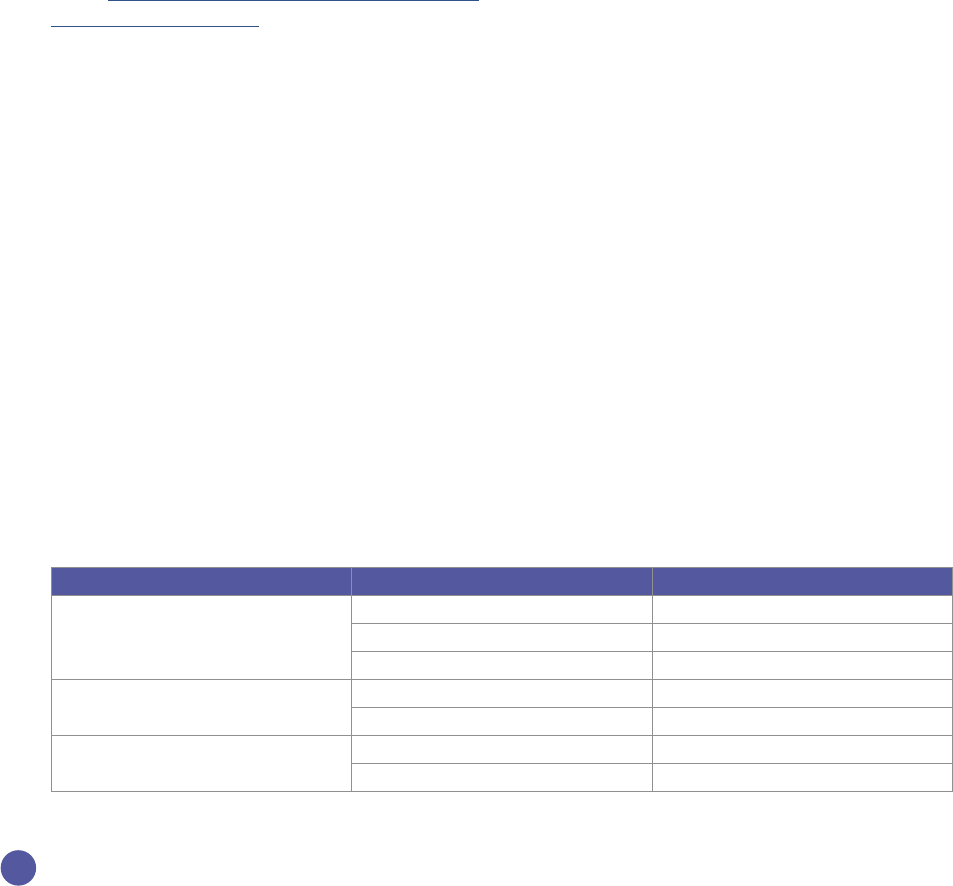
20
Section 3: Case studies and evaluation
Sections 1 and 2 of the report focus on the
benefits of increasing mobile Internet and
broadband connectivity and the barriers faced
by individuals seeking to acquire Internet-
enabled phones. Section 3 explores real-world
case studies of interventions that have been
implemented to address these barriers and
make smartphones accessible to all.
3.1 Methodology
Research methodology
The work presented in this report was
completed through a series of engagements
of the Broadband Commission Working Group
on Smartphone Access between November
2021 and August 2022. Initial discussions of the
Working Group focused on the current state of
smartphone access and barriers to smartphone
access. Insights from these discussions
contributed to sections 1 and 2 of the report.
Empirical evidence presented in section 3 was
gathered through extensive desk research
supported by structured interviews with experts
well-versed in the initiatives implemented to
address smartphone access. In total, 19 expert
interviews were conducted. The International
Trade Center convened a focus group of
ten entrepreneurs involved in smartphone
distribution. In addition to the interviews
and focus group discussions, data were also
generated through review of documents,
some not publicly available, provided by the
participants.
The input from Working Group members and
other interviewees suggested seven categories
of interventions to promote smartphone access.
Where possible, these interventions were
evaluated based on their positive impact on
reducing device cost or on the number of total
devices sold. When specific data on financial
outcomes were unavailable, success was
inferred from other criteria, such as whether
the initiative remained ongoing or had been
terminated (which was often the case), the
number of times it had been renewed, and
the extent to which experts characterized
an initiative as a success. These data
support classifying them into higher priority
interventions, interventions that merit further
exploration, and lower priority interventions.
3.2 Higher priority interventions
3.2.1 Higher priority intervention –
device financing
Device financing represents one of the
most common interventions in promoting
smartphone access.
Converting the upfront cost of smartphones
into instalment payments makes devices
affordable for those unable to save enough
money to cover the purchase price of the
device. Effective designs for device financing,
Strategies Towards Universal Smartphone Access
Table 1: Classification of case study interventions
Classification Intervention Case study count
Higher priority interventions
Device financing 12
Taxes and import duties 8
Improved distribution channels 11
Interventions that merit further
exploration
Device subsidies 11
Reuse of preowned 6
Lower priority interventions
Local manufacturing 3
Smart feature phones 6

21
like affordable loans with flexible payments,
help to make 4G devices easily available and
enable control of payment patterns according
to incomes. Customers can access device
financing through Mobile Network Operators
(MNOs), formal and informal financial
institutions, alternative credit providers, or
government initiatives.
Opportunities for device financing
Photo credit: ©ITU
Flexible options to help customers fit their
payments to their income
Customers who earn money daily often find
it difficult to set aside funds for monthly or
even weekly payments. Steps that make it
easier for customers to meet their financing
obligations lower the risk that device financing
programmes must bear.
In addition, a large population of low-income
customers live on unpredictable income cycles
that are prone to economic and seasonal
fluctuations.
1
Most of such individuals do
not have access to Internet-enabled mobile
devices. Many device financing schemes fail
to consider that customers (like small-holder
farmers) may have lumpy income streams.
Having fixed payment structures may force such
customers to default on their payments.
MNOs, device manufacturers, and other
financiers have become increasingly open to
helping such individuals by providing them
with greater flexibility in setting the payments in
their device financing schemes.
Mobile money to improve customers’
repayment options
Mobile money provides smartphone financiers
with a cost-effective way to collect regular
payments from customers dwelling in remote
areas with relatively low transfer fees. This is
especially helpful to customers who cannot
afford the regular travel costs to service centres
to pay in cash. Smartphone financiers have
taken advantage of mobile money platforms
for promoting digital and financial inclusion
and have witnessed significant uptakes among
regions with active mobile money users.
Alternative credit assessment to include
customers with no formal credit history
Unorthodox credit rating mechanisms are
especially helpful to customers whose only
other option to purchase a smartphone would
have been to carve out cash from their savings.
Financiers can use information from mobile
money transactions, such as current income
levels, transaction records, saving patterns,
utility bill payments, and cash flow data to
assess the creditworthiness of potential
recipients of device financing. Financiers
can also use mobile money data to observe
repayment patterns of active loans, which help
them manage and reduce default risk. Such
mechanisms are especially helpful for the
underbanked populations with no formal credit
histories.
Other non-traditional methods for assessing
creditworthiness, such as assessing airtime,
data consumption, and household expenses,
allow for vast expansion of smartphone access
while also improving financial inclusion in
communities that need it the most. Globally,
there are more than 200 start-ups with
promising innovations on alternative credit
assessment.
2
Device locking mechanisms to reduce the
risks of bad debt and theft
Device locking mechanisms allow lenders of
smartphones to remotely lock an Internet-
enabled phone if it is stolen or if customers fail
Strategies Towards Universal Smartphone Access
Section 3

22
to make their repayments. This technology is
especially helpful for customers vulnerable to
theft and those whose creditworthiness cannot
be determined.
Today, manufacturers use innovative
technologies to implement effective hardware
and software locks. Smartphone manufacturers
have devised their own methods to lock
smartphones, including Google’s Device Lock
Controller (DLC), which operates on Android,
and Samsung’s Knox. With the advancement
of the locking technology, software companies
like PayJoy and NewPath have specialized in
smartphone financing with remote locking and
partnered with various lenders to offer device
financing services.
Partnerships with outside organizations to
share financing burden
MNOs and device manufacturers often partner
with financial institutions to take the burden off
their balance sheet and share the risks.
Formal financial institutions can rely on
traditional approaches to credit assessment
to provide smartphone financing. Formal
institutions have a significant advantage in
being able to efficiently assess their customers’
credit risk based on bank account tenure,
incomes, and credit histories when those data
are available.
Informal financial organizations like
microfinance institutions (MFIs), self-help
groups, joint liability groups, and cooperatives
can help expand digital inclusion to
underbanked communities by utilizing their
established credit scoring mechanisms or
existing group liability programmes to help
their customers access smartphones.
Governments can partner with formal banks or
MFIs to provide device financing by providing
risk capital for smartphone loans and low or
zero interest liquidity. Governments can use
their involvement in such partnerships to target
populations that would benefit the most from
increased smartphone access.
Challenges for device financing
Large initial capital requirement to finance
devices
Firms offering device financing need first to
purchase the devices and then recoup that
investment through instalments payments
from customers over several months. Any actor
seeking to offer device financing must thus
raise a significant amount of capital to finance
the purchase of the devices and then carry the
value of the devices on their balance sheets.
Risk of bad debt
Individuals targeted by device financing
initiatives, especially those aiming to use low
and flexible instalment plans, might not be able
to repay these loans. This in turn requires firms
offering device financing to incur costs for bad
debt. Financiers who do not have information
about their creditworthiness must necessarily
charge higher interest rates to compensate
for their higher bad debt costs. This effectively
increases the price these customers must pay
to acquire mobile phones, which makes them
less accessible.
Lack of handset insurance for financed
devices
The customer base that needs device financing
the most also requires protection against
damage and theft, as they cannot afford to
continually pay for repair or for new handsets.
However, adding insurance against theft or
damage increases the overall price of the
smartphones, which the customers may not be
able to afford.
Further, the smartphones purchased among
the low-income households are entry level
devices, a difficult segment for insurance
companies’ risk assessment.
Strategies Towards Universal Smartphone Access

23
Photo credit: © WHO / Faith Kilford Vorting
Gender bias in credit assessment
Several analyses by MFIs have shown that
women are often lower risk customers than
men.
3
Despite such evidence, alternative
credit score assessment algorithms have been
reported to be unintentionally biased against
women. For example, using credit scoring
thresholds for the number of SMS sent, time
spent on calls, or the number of top-ups might
be biased against women. This can result in the
widening of the gender gap in mobile Internet
usage, as creditworthy women are more likely
to be denied credit than creditworthy men.
4
Empirical evidence for device financing
Device financing appears to be the most
frequently pursued programme for increasing
smartphone access. The Working Group
identified 20 case studies on device financing
and profiled 11 of them in depth for this report.
Flexible payment options were implemented
by seven case studies. Seven case studies
expanded upon partnerships with financial
institutions, five of which were long-running
initiatives. Four programmes employed device
lock technologies and four used alternative
credit scoring mechanisms. Four initiatives used
mobile money for efficient payment processes.
The report also evaluated three case studies on
government device financing initiatives.
The sheer number of initiatives on device
financing demonstrates its popularity and
relevance in addressing key barriers to
smartphone access. This study also conducted
extensive key stakeholder interviews and focus
group discussions with industry experts to
drive deeper understanding about smartphone
financing. The following are some key elements
of device financing observed in different case
studies from the analysis.
Empirical evidence for flexible payment
options
Seven case studies in this research confirmed
that successful device financing programmes
allowed customers to choose between daily,
weekly, or monthly regular payment options
according to their convenience.
As an example, MTN Uganda offered their
customers a scheme to purchase their 4G
MTN Kabode smartphones through six-month
instalment loans. This initiative allowed early
payments, daily, weekly, or monthly payments
so long as the required amount of UGX 50,000
(USD 5.7) was paid per month.
5
M-KOPA offered one of the most popular mid-
tier phones (Samsung A12) for a deposit of
KSH 4499 (USD 40) and daily payments of KSH
70 (USD 0.6) over twelve months. In the retail
market, the same phone would cost an upfront
payment of KSH 19,199 (USD 171). They also
helped customers who have seasonal income
by assisting them to make their micropayments
in advance depending on when they have
financial inflows.
6
Safaricom’s device financing partnership with
Google known as Lipa Mdogo Mdogo (which
means ‘pay little and often’ in Swahili) allows
existing customers with 2G or 3G phones and
no pending loans to purchase their flagship
Neon Ray 4G device and other smartphones.
7
The above initiatives also allowed for flexible
payments where customers were encouraged
to make payments higher than the required
amount when they could.
Empirical evidence for device financing for
marginalized communities
Sonata Finance and Vodafone Smart Snehidi
initiatives, both in India, addressed the key
gender gap between men and women
Strategies Towards Universal Smartphone Access
Section 3

24
accessing smartphones by focusing on women
entrepreneurs of microenterprises to help them
acquire Internet-enabled devices to aid their
businesses. Such women-centric approaches
are especially helpful in India where women are
around 21% less likely than men to use mobile
Internet.
8
Smart Snehidi provided microloans
to low-income women entrepreneurs for the
purchase of smartphones. Sonata Finance also
took the additional initiative to help educate
people about the advantages of women using
mobile Internet and owning smartphones
by building a rapport with the elders of rural
communities and directly addressing the
cultural barrier of female smartphone access.
Empirical evidence for use of mobile
money platforms for device financing
Device financing programmes have depended
on several enabling technologies. Over the
past decade, mobile money has become a
mainstream financial service. There are an
estimated 1.35 billion registered mobile
accounts carrying out over USD 1 trillion
transactions in a year.
9
Four device financing initiatives studied in this
report—Fenix International device financing,
Mobisol device financing, (now called Engie),
Safaricom Lipa Mdogo Mdogo, and M-KOPA—
use mobile money. Safaricom indicated that
M-PESA was a vital part of their device financing
programmes, helping them not only to improve
their customers’ repayment experience but also
to screen and qualify them for device financing
using M-PESA data. As of December 2021, the
M-PESA app was downloaded by more than 4.2
million users.
10
M-KOPA financed a significantly higher
number of smartphones in countries with
deeper penetration of mobile money, such
as Kenya, Ghana, and Uganda, despite lower
customer purchasing power compared to
regions like Nigeria, where mobile money is still
developing.
Safaricom, in partnership with CBA, launched
M-Shwari, a savings and loan product that
utilized mobile money data to analyse their
existing customer base and extend six-month
loans to provide smartphone access.
11
Empirical evidence for alternative credit
scoring
Four case studies reviewed in this report
involved innovative methodologies for
assessing customer credit when traditional
measures of creditworthiness were unavailable.
The use of alternative credit scoring gives
financiers a chance to reduce bad debt risk by
pre-vetting the potential borrowers.
For example, MNOs like Vodacom use network
data to assess their existing customers for loan
eligibility by monitoring their talk time, top ups,
SMS rates, data consumption patterns, and
number of years on the network.
Mobisol, a solar energy company in East Africa,
used data points such as family size, household
income and expenses, and land tenure, to build
a reliable credit profile for their customers.
Safaricom employs its own scoring system
based on machine learning algorithms that
assess users’ creditworthiness. It uses data
gathered from M-PESA payments to qualify
their customers for device financing.
While these credit assessments may not
provide as much insight as traditional measures
of creditworthiness, they facilitate providing
digital and financial inclusion to people who
would otherwise not be able to enjoy those
benefits.
Empirical evidence for device locking
technologies
Three device financing programmes in this
study implemented some form of device
locking technology. Safaricom’s Lipa Mdogo
Mdogo uses device locks technologies to
reduce bad debt expenses by nudging
customers to make regular payments. When
the customer is delayed in their payment,
MNOs take a series of steps until the payments
resume. Device locking helped reduce default
rates for this programme to as low as 10%.
Strategies Towards Universal Smartphone Access

25
Vodacom launched the Easy2Own device
financing programme in 2021 to accelerate
migrations from 2G and 3G devices to 4G
devices with two complementary solutions,
both of which used device locking mechanisms.
Initially, Easy2Own targeted Vodacom’s
current 2G and 3G customers, assessing their
creditworthiness based on the company’s
experience with them and carrying the financial
risk on its own balance sheet. Vodacom now
partners with PayJoy and other commercial
financing institutions to offer financing to
non-Vodacom customers, with their financing
institutions carrying the risk instead. In both
cases, device locking technologies help
reduced bad debt risk.
Trustonic’s locking system sends full screen
warning messages on smartphones upon
late payment and locks the device upon
non-payment. An anonymous Trustonic
MNO customer confirmed that smartphone
delinquency reduced from 35% to 11% due
to Trustonic device locks, reducing MNO risk
of bad debt and device theft. It also attested
that Trustonic locks allowed it to reduce bad
debt by 70% and to recover bad debt 39%
faster, reducing it from over a month to less
than fifteen days, with 70% increase in debt
collection rates. With lowered commercial risk,
credit application approvals increased over
100%, allowing the MNO to offer loans to more
customers and broaden digital inclusion.
While the results from programmes with device
locks look impressive, it is important to note
that most of these initiatives are fairly new (the
above have been available for less than three
years) and that detailed data on their impact on
the willingness to extend credit remain scarce.
Further studies are needed to demonstrate
concrete success in device financing.
Empirical evidence for strategic
partnerships with formal financial
institutions for device financing
Device financing programmes have also
benefited from strategic partnerships with
formal and informal financial institutions. In
total, seven case studies evaluated in this
research showed the benefits of MNOs, device
manufacturers, and other mobile phone
creditors seeking out financial partners to take
the large investments off their balance sheets
and share the burden of high risk.
The First National Bank (FNB) of South Africa
partnered with MNO Cell-C in 2015 to provide
device financing to FNB customers through a
programme called FNB Connect. This initiative
was able to provide loans for up to 24 months.
The resulting prices are cheaper than the retail
prices for the same phones. Over 800,000
customers had employed FNB Connect’s
financing scheme to purchase smartphones by
2020, which earned FNB Connect the Virtual
Network Operator of the Year award in2022.
In Vodacom’s Easy2Own initiative, PayJoy
was one of the official financial partners that
allowed Vodacom to open up its programme
for existing prepaid customers to any customer,
including those who lacked creditworthiness
information. As the financial partner, PayJoy
carried the full risk of all financing extended to
customers without credit histories, which led it
to charge them higher prices for smartphones
than Vodacom was able to charge its existing
customers. Since its launch in December 2021,
the Easy2Own PayJoy initiative has reached
20,000 customers.
Similarly, the M-KOPA device financing
programme in Africa partnered with MNOs
in Kenya, Uganda, Nigeria, and Ghana to
acquire 1 million smartphone customers in
just one year, enabling approximately 750,000
customers to purchase a smartphone for the
first time.
12
This programme has benefitted
from synergies with M-KOPA’s longstanding
programme for financing for solar home
systems.
Equity Bank in Kenya partnered with Airtel
Kenya in 2015 to launch their own MVNO
called Equitel. Equitel offered affordable loans
for dual SIM Samsung and Alcatel smartphones
between a four to twelve-month loan period
through their “Loans for Smartphones”
initiative.
Warid, a Pakistani MNO, partnered with Bank
Alfalah to offer its postpaid customers owning
Strategies Towards Universal Smartphone Access
Section 3

26
Bank Alfalah Credit Cards an instalment plan to
purchase smartphones at 0% interest over six to
twelve months. The programme also includes 8
GB of free Internet per month for the duration
of the loans.
13
Empirical evidence for strategic
partnerships with informal financial
institutions for device financing
Informal MFIs and other informal institutions,
like MFIs, such as cooperatives, self-help
groups, and joint liability groups, have
the advantage of pre-existing networks of
individuals which can offset the high risk
through group collateral systems. For example,
Sonata Finance leveraged their pre-existing
joint liability groups to offer credit to women
entrepreneurs belonging to low-income
households to purchase smartphones without
the prerequisite of collateral.
Informal financial institutions are also partnering
with MNOs to provide affordable handsets to
their customers. For example, Vodafone India’s
Smart Snehidi microloan programme partnered
with nonprofit organization Hand in Hand and
utilized the strong network of women in self-
help groups and used the group liability model
as a contract for settlement.
14
Empirical evidence for government
initiatives for device financing
This report evaluated three case studies on
government initiatives for device financing, two
of which partnered with MNOs to meet their
socioeconomic goals of improving smartphone
access.
In Pakistan, the government of Punjab
partnered with Tameer MFI and MNO Telenor
to increase smartphone access among
approximately 490,000 small-holder farmers
in the province by distributing Rs. 79 billion
(USD 11.4 million) in interest-free loans. These
smartphones also had preinstalled agriculture
related apps for their target customer base to
help them increase their income.
In 2013, the Malaysian Government
encouraged 3G smartphone purchase among
its youth by offering USD 45 rebates on USD
112 handsets. MNOs acted as a channel to
facilitate the rebates between the customers
and the government.
In 2016, the President of Argentina launched
the “Plan Mobile Internet Access” initiative
to help 8 million individuals to migrate from
2G feature phones to 4G smartphones by
providing asset financing for the same.
Empirical evidence for customer
engagement to support device financing
Many initiatives lacked an integrated approach
to smartphone financing that addressed other
barriers to adoption. It is difficult to generate
demand for smartphones when financing
initiatives do not make efforts to engage with
their customers and address issues like lack of
confidence or awareness.
Safaricom’s Lipa Mdogo Mdogo initiative
helps their customers by engaging with them
through their sales team, interacting with
them through customer value management
(CVM) models, bringing distributors to their
areas, and guiding the customers through the
journey of smartphone acquisition. This holistic
approach has helped Safaricom acquire new
customers, improve customer loyalty, and
improve smartphone access by being proactive
in increasing their device financing application
approvals.
15
It is important to highlight that this study did
not come across sufficient evidence to draw
strong conclusions on customer journey
assistance being necessary for device financing,
but it is helpful in making the device financing
programmes more effective.
3�2�2 Higher priority intervention – taxes
and import duties
Taxes such as excise taxes, VAT, and import
duties are components of the total device
cost. Higher taxes and import duties translate
into higher retail prices for smartphone
devices. They also create an environment that
encourages black markets (which mainly sell
Strategies Towards Universal Smartphone Access

27
illegally imported devices) to become the main
distribution channel for smartphones. These
black-market phones are often of lower quality
and poorer purchase experiences. A reduction
of taxes and import duties has the potential
to reduce device costs, which can improve
affordability and result in increased access to
smartphones and boost the digital economy.
16
However, taxes are important to support an
economy, and reducing dependence on
imports helps in protecting local industry.
Thus, a balanced approach is required towards
adjusting taxes and import duties.
Opportunities for taxes and import duties
Increased consumption of digital services
Governments express concerns that the
reduction and/or removal of taxes and import
duties can negatively impact revenue targets.
However, evidence indicates that reductions in
taxes lead to increased penetration of Internet-
enabled devices (smartphones), which in turn
translates into increased consumption of digital
services and other services accessible through
digital platforms.
In 2021, mobile technologies and services
generated USD 4.5 trillion of economic value
added, or 5% of GDP, globally. Reduction
in taxes for mobile handsets and services
reduces the total cost of mobile ownership
to customers, thus increasing demand
for smartphones and mobile Internet and
contributing to the global GDP. The mobile
industry is also rigorously increasing jobs and
investments, which has a further positive impact
on the economy.
In Africa, the International Telecommunication
Union (ITU) estimated that a 10% increase
in mobile broadband penetration would
yield a 2.5% increase in GDP per capita.
17
Taxes on smartphones provide short-term
revenue gains but may prolong or dampen
other government initiatives aimed at
increasing levels of digital connectivity.
Increased connectivity generates revenue for
the government through higher economic
activities and taxes levied. Furthermore, digital
connectivity positively impacts foreign direct
investment as investors find countries with
higher Internet-related services and digitally
engaged consumer markets to be attractive
investment opportunities. Governments may
also consider studying the short- and long-
Strategies Towards Universal Smartphone Access
Section 3
Recommendations for device financing
The large number and longstanding persistence of device financing case studies attests to
the popularity and effectiveness of these programmes. This well-received intervention can
be implemented by stakeholders with some learnings in mind.
• Allow customers to choose the frequency of their instalments to enable them to control
their finances and increase confidence in loan repayments
• Design targeted financing for marginalized communities, such as women, people from
remote locations, and low-income individuals
• Integrate device financing initiatives with mobile money to support customer
repayment practices and provide potential financiers with creditworthiness data
• Use device lock technologies to reduce the cost of device financing
• Take a holistic approach by increasing customer engagement with the financing service
and guiding them through the whole process of acquiring and using a smartphone

28
term economic and social benefits of reducing
taxes and import duties on smartphones and
other ICT devices. This study can also include
the economic benefits of increased use of
e-government and e-commerce services.
Joining trade blocs reduces taxes and
duties
Another opportunity for reducing taxes and
import duties is an increase in regional trading
blocs. As an example, African countries can
participate in the African Continental Free
Trade Area (AfCFTA). This agreement allows
for free movement of goods. Given that
the number of smartphone manufacturing
factories are increasing on the continent, there
is an opportunity that AfCFTA could play an
important role in reducing taxes and import
duties.
Challenges for taxes and import duties
Replacement of taxes/import duty revenue
reductions with new digital taxes
Taxes and import duties contribute significantly
to government revenue. Any attempts to
reduce and/or eliminate these taxes and import
duties are often met with resistance from
ministries of finance. To compensate for lost
revenue, some governments are introducing
new forms of taxes, mainly focusing on digital
services. These taxes result in an increase in
the overall cost of mobile ownership to the
customer, raising the affordability barrier and
limiting smartphone penetration.
Beliefs that mobile phones have reached
critical mass
There are also indications that some
governments believe that mobile phones have
reached a saturation point. This has resulted in
governments levying taxes on these devices in
the same bracket as luxury goods.
Empirical evidence for taxes and import
duties reform
In this study, mobile-related tax policies of 13
countries were evaluated. Evidence shows
that the taxes imposed on customers are a
significant determining factor of affordability.
Consumer taxes are approximately 19% of
the total cost of mobile ownership globally.
Countries with highest mobile-related taxes
report to have the highest total cost of mobile
ownership.
18
Consumers from low-income
backgrounds are particularly sensitive to price
changes in mobile services, and over-taxation
on digital goods and services can limit their
adoption of the mobile Internet.
Research found that lowering the burden of
taxes for customers is associated with higher
potential for mobile connectivity, especially
with low-income populations. Countries with
lower taxation levels have more affordable
mobile services and better connectivity
performance.
19
Empirical evidence for different
approaches to taxes and import duties
In 2021, the Tanzanian authorities announced
a value-added tax exemption on smartphones
to encourage the use of telecommunication
services and increase Internet penetration
from 46% to 80% by 2025.
20
The government
believed that the budget proposal would
encourage increased data consumption in
the country and would expand the number
of citizens who are financially and digitally
included, although discussed later, the benefits
of this tax cut were mitigated by the increase in
taxes on mobile money transactions.
Similarly, in 2016, to make basic smartphones
more affordable, the Colombian government
removed VAT from mobile devices costing
less than USD 225. Most importantly, this cost
threshold led mobile device manufacturers to
re-price handsets that were just above the VAT
exemption threshold to just below it, making
medium and lower tier mobile phones even
more affordable for Colombians. Countries
such as Rwanda and Senegal also exempted
handsets from VAT.
Strategies Towards Universal Smartphone Access

29
On the contrary, in 2009, authorities in Kenya
exempted mobile handsets from VAT, only
to reverse course in early 2022 by imposing a
10% excise duty on the importation of cellular
phones in addition to a KSH 50 excise duty on
every imported ready-to-use SIM card. Pakistan
increased import duties by 240% in 2021 to
encourage local production. Similarly, the
Ugandan government also imposed 10% tax on
imported smartphones in 2020.
Empirical evidence for the contribution of
tax reductions to increasing smartphone
penetration
Reductions in value-added taxes and excise
duties reduce the total cost of ownership of the
nation’s mobile users, improving affordability
for smartphone access. However, it is important
to note that the tax reforms must be studied
over an adequate period to make a reasonable
cost-benefit analysis.
Vodacom reports show after the reduction of
VAT in Tanzania, smartphone penetration and
data use increased. Smartphone penetration
in Tanzania improved from 31.2% to 33%
between August 2021 and May 2022. However,
it is noteworthy to indicate that the increase in
smartphone penetration and data use cannot
be entirely attributed to VAT reduction given
that Vodacom had other initiatives.
Smartphone adoption in Colombia before
the VAT exemption was well below regional
averages, but it had one of the region’s highest
mobile ownership rates after the tax reform.
21
Samsung Colombia reported a 28% increase in
units sold in the first quarter of 2017 compared
to the same period in the previous year. Huawei
reported that their sales increased, since 80%
of their sales constituted medium-to-low range
devices that fell within the VAT exemption.
22
In 2016, Pakistan also removed the 16% VAT
on mobile handsets. Handset sales increased
by 25% in Pakistan after the VAT exemption,
compared to an average of around 3% in India
and Bangladesh.
23
The 2009 exemption of 16% VAT on mobile
handsets in Kenya resulted in over 200%
increase in the sales of mobile devices
and increase in unique mobile subscriber
penetration from 29% to about 40% in the
following three years. During these three
years, the contribution of mobile to the Kenyan
economy grew by over 250%, and employment
related to mobile services increased by 67%.
24
Although there is insufficient evidence of the
latest impact of VAT reduction/exemption on
mobile phone penetration in these countries,
the immediate results that followed the tax
reforms suggest that they led to substantial
improvements in mobile affordability.
Empirical evidence for substitution of tax
reductions with other tax increases
Several countries explored compensating
for the loss in revenue due to mobile tax
reductions with an increase in taxes on Internet-
related services. One such example is an
increase in mobile money taxes. Most of the
customers benefiting from mobile money are
from marginalized groups who were previously
financially and digitally excluded. Increases in
taxes on mobile money can have a large impact
on their mobile usage patterns and negatively
affect their livelihoods.
For example, shortly after the VAT exemption
for smartphones in Tanzania, the government
imposed a levy on mobile money of TZS 10,000
(USD 4.29) per transaction.
25
Many mobile
money agents lost more than half of their
customers when the tax was imposed. The
Vodacom Group reported that their revenue
from international operations was dragged
down by over 40% due to the concomitant
introduction of a tax on mobile money
transactions.
26
Peer-to-peer transactions on
mobile money in Tanzania dropped by 38%
from 30 million to 18 million per month.
27
The
government reduced this tax soon after the
backlash to TZS 7,000 (USD 3) per transaction
and then in June 2022 to TZS 4,000 (USD 1.72)
per transaction.
In 2017, at the same time the Colombian
government exempted mid-low range
smartphones from VAT, it increased VAT
on mobile services from 16% to 19% and
Strategies Towards Universal Smartphone Access
Section 3

30
imposed an additional 4% consumption tax
for mobile data plans above USD 16, which
had serious implications for the country’s data
consumption.
28
The increase in tax burden on customers due
to taxes on sectors related to smartphone
access has raised concerns in many countries,
with experts worrying that the higher taxes may
reverse the improvements made in financial
and digital inclusion.
For example, in 2019, the Ghanaian
government increased the communications
service tax from 6% to 9%, announcing that
the higher rate was intended to develop
the foundation for the creation of a viable
technology ecosystem in the country. During
the COVID-19 pandemic, Ghana reduced its
communications service tax from 9% to 5% in
mid-2020 to assist people who work remotely
and use online services. Ghana also imposed a
1.5% tax on mobile money transactions above
USD 13 after the pandemic, which popularly
came to be known as e-levy. This resulted
in the population of Ghana turning back to
paying with cash rather than using electronic
payments, resulting in substantial losses to the
industry and forgone benefits to consumers.
29
Research shows that increasing taxes on mobile
services, including electronic transactions, may
not significantly increase the tax base but can
overturn achievements in access and inclusion.
Low-income earners are most sensitive to
price changes in digital services, and such
taxes discourage and disincentivize them
from smartphone and mobile Internet usage.
For example, the total contribution of mobile
money taxes in Kenya represented less than 1%
of total tax revenue, which is negligible for the
government but imposes high economic costs
on low-income customers.
30
However, reduction in such taxes can bring
significant economic benefits. GSMA estimates
that the removal of 4.2% excise duty on mobile
services in Argentina would result in mobile
penetration increasing by 1 million unique
subscribers, a 2.1% increase. As a result, GDP
can grow by USD 1.83 billion.
31
Empirical evidence of the ineffectiveness of
import duties in protecting local industries
Many countries in the emerging markets
impose customs duties on imported
smartphones. Often, these increases in
import duties are imposed to encourage local
manufacturing. Research shows that import
duties do not yet have a clear impact on
protecting domestic industries.
32
In 2021, Pakistan increased import duty on
smartphones by up to 240%. According to
the Pakistan Bureau of Statistics, the import of
smartphones still increased by 7.43% in the first
ten months of the 2021-22 despite the increase
in local manufacturing.
33
The government of Uganda imposed a 10%
import duty on smartphones in 2020 with
the aim of increasing the adoption of locally
manufactured devices as the country was
gearing up for the mass production of its first
smartphones.
34
The study did not find any
information on the overall reduction of costs to
customers due to local manufacturing.
35
Increased import duties raise the cost of
ownership to customers of impacted phones,
limiting mobile Internet penetration. A report
by the GSMA found that a reduction in customs
duties of 35% to 12% in Argentina would
increase unique subscribers by 0.17 million.
36
Reflecting this insight, Colombia has decided
to exempt digital services from import duties to
decrease the cost of acquiring these services to
customers and improve ICT adoption.
37
Empirical evidence for removal of VAT
exemptions
In its Finance Budget of 2022, the Tanzanian
government announced the removal of VAT
exemption for smartphones, as they believed
it did not lead to reduction of final prices to
customers but only benefited traders.
38
Analysts
report that there are no data to support this
claim.
Tax reforms on mobile usage take time to reap
benefits and demonstrate success on a national
scale. Besides, quick changes to such taxes can
Strategies Towards Universal Smartphone Access
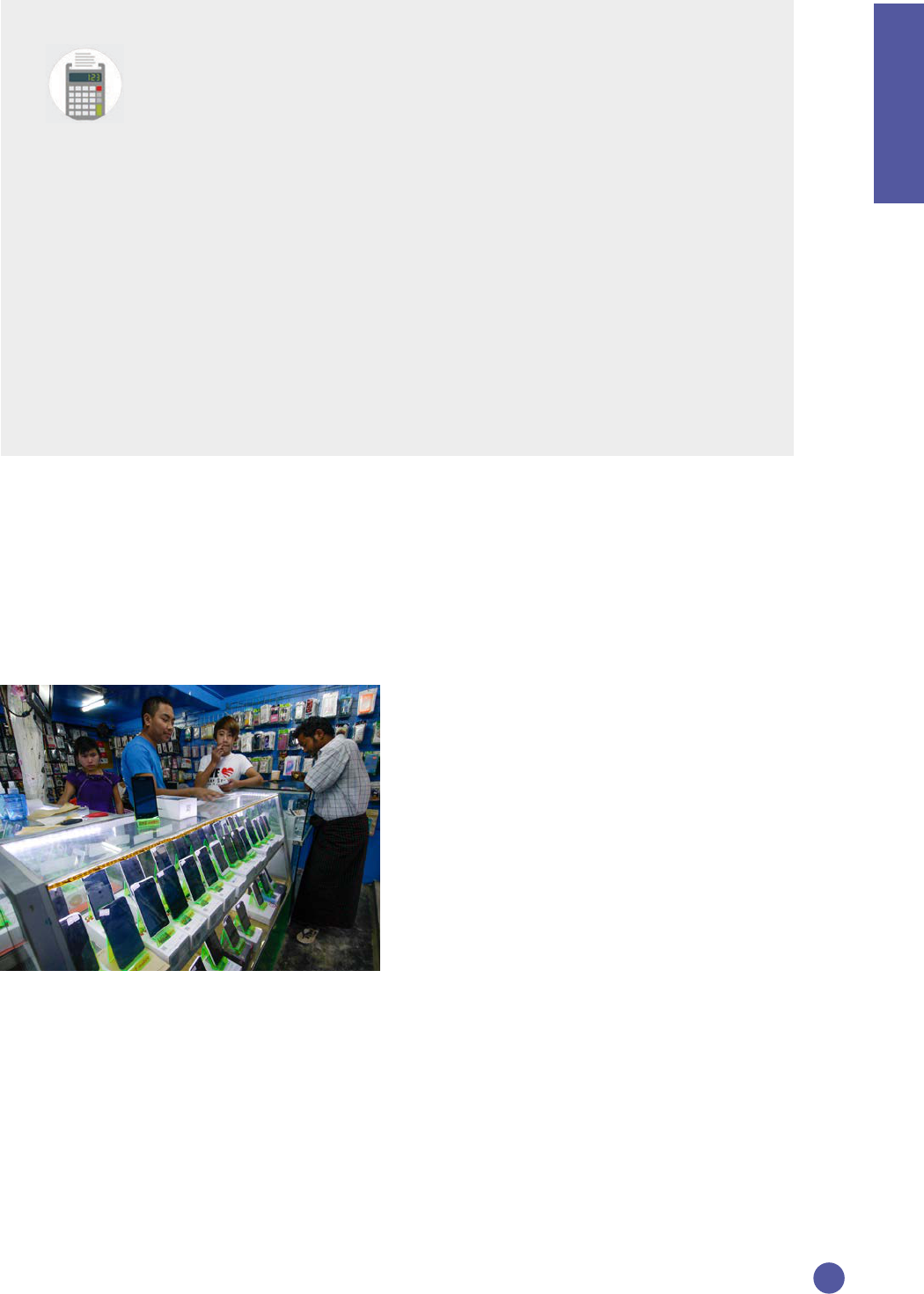
31
cause an environment of instability and would
discourage international investments in the
mobile sector.
3.2.3 Higher priority intervention -
improved distribution channels
Photo credit: ©Asian Development Bank
Efficient distribution channels address the
issue of lack of availability of handsets for those
living in remote locations with limited retail
stores, ensuring that the handsets reach people
at lower costs. In these areas, customers are
susceptible to inflated prices due to low supply
and distance from nearby towns.
On average, existing retail and wholesale
distribution channels in emerging markets do
not sufficiently cater to all potential customers.
Opportunities exist to fill this gap and
provide better service while reducing costs to
customers. New opportunities for partnerships
with different stakeholders have emerged to
improve last-mile distribution networks due to
the common interest of the parties to increase
availability and affordability of smartphones.
Opportunities for improved distribution
channels
Expanding retail footprints
MNOs, device manufacturers, and other
stakeholders can collaborate with established
retail chains to widen their reach. Retail outlets
can also help by raising awareness of the
services offered and provide a trusted point of
contact with local communities.
Agent-based distribution models
In areas with limited retail presence, agent-
based models are utilized. These models
depend on a network of agents who are trained
to make orders of smartphones on behalf of
customers and to help them select a device
Strategies Towards Universal Smartphone Access
Section 3
Recommendations for taxes and import duties
• Design tax reforms to consider the benefits of mobile broadband penetration.
• Set a long-term, balanced approach to taxation to meet domestic revenue collection
objectives and provide a conducive environment for digital inclusion and economic
development.
• Examine the total cost and net impact of mobile ownership when designing tax
reforms.
• Reduce taxes for devices below certain thresholds to incentivize smartphone
manufacturers to cut prices to make their smartphones eligible for tax reduction/
exemption.
• Provide a simple, progressive, equitable and stable tax system to attract international
investments and facilitate a nation's transition into a digital economy.

32
based on their needs. Agents must also have
the capacity to manage liquidity and accept
deliveries.
39
Online marketplaces
Online platforms and social media platforms
provide options for accessing new and
refurbished low-cost Internet-enabled handsets
without having to travel to specific locations
that have established retail stores.
Organized communities for distribution
Many emerging markets have established
savings-based cooperatives and joint liability
groups. These groups typically have strong
interpersonal networks with high engagement
and trust levels among their members. Further,
they also serve as a base for device financing
initiatives.
Replacement for parallel markets
Parallel markets, also known as black markets,
for electronics proliferate particularly in rural
and low-income areas. Mobile devices sold
through these markets are often of low-quality
with no maintenance or warranty offerings.
Even though devices sold in these markets
seem cheaper, customers often end up
receiving very less value for the money they
spend on such smartphones.
Challenges for improved distribution
channels
First-time smartphone buyers’ preference
to see devices before purchasing them
Some low-income customers in emerging
markets still distrust e-commerce platforms
and would prefer to physically examine the
products before purchasing them. This is
particularly true for smartphones, which are
costly. Even in the agent-based distribution
model, most sales agents only have a catalogue
or tablet with product ranges shown and
typically do not carry any sample phones to
show customers.
Low skills of some agent-based distribution
channels
The effectiveness of agent-based distribution
models is highly dependent on the skills of
the agents. If the agents are not well-informed
about the smartphone products offered,
customer acquisition can be limited. Some
agents are also not aware of the supportive
offerings provided by distributors, like saving
schemes or financing, which could vastly help
customers acquire smartphones and increase
the company’s customer base.
Empirical evidence for improved
distribution channels
This research studied eight cases on
distribution channels and found that effective
ways to provide last-mile coverage for
distribution channels, especially to rural and
low-income people, have the potential to
broaden reach and improve smartphone
access. The distribution of these case studies
was as follows: two case studies on expanding
retail footprints, one case study on structured
agent-based distribution models, three case
studies on online marketplaces serving as
substitutes to retail outlets, and three case
studies on leveraging organized communities
for improved distribution channels.
The study found that rural and low-income
communities have less time on their hands
and lower disposable income, especially for
women. Bringing handset offerings to their
doorstep reduces the time and cost barriers to
smartphone ownership. The following are some
of the key findings of the research.
Empirical evidence for expanding retail
footprints
MNOs can broaden their customer base in
rural areas by partnering with pre-established
retailers in nearby areas. For example, MTN
South Africa partnered with the Edcon retail
group during the launch of their flagship MTN
Steppa phones. MTN leveraged the footprint of
Edcon group through this alliance, which had
1,273 stores nationally.
40
Strategies Towards Universal Smartphone Access

33
Tecno Mobiles operates a franchise retail
distribution network in Ghana, Cameroon,
Nigeria, Mozambique, Kenya, Tanzania,
Uganda, and Ethiopia to sell Tecno Mobiles’
devices. In countries like Tanzania, this retail
franchise network has established a strong
presence in rural areas, improving smartphone
access to populations that are typically harder
to reach.
41
Tecno Mobiles has sold more than
45 million mobile phones in the African market
and accounts for approximately 50% of the
market share.
Empirical evidence for structured agent-
based models for rural distribution
Structured networks of agents help meet
the demand for smartphones in peri-urban
and rural areas. They communicate with
local residents and provide them product
catalogues. They may also offer an individual or
group-based savings plans to assist customers
in purchasing the device of their choice. Some
networks also offer mobile money as a method
of making payments.
Copia, launched in 2013, is a consumer
catalogue order and delivery company which
uses the agency model to sell smartphones
to the base of the pyramid (BoP) customers.
Copia’s strategy is to recruit small business
owners who have established relationships with
local populations and train them to be sales
agents.
42
With the Copia agent-based distribution
model, a typical rural customer from Kenya
could avoid KSH 500 (USD 5) on a roundtrip
bus fare to the nearest town to acquire a
smartphone. Customers can also have a savings
plan with the local sales agent through a
“layaway plan,” where they deposit money with
the agents until they have accumulated enough
capital to purchase a smartphone. However,
some Copia sales agents are not well-versed
in Copia’s offerings and often need focused
training sessions to assist their customers.
Copia customers also reported being unsure of
buying smartphones from catalogue pictures or
application-based information.
Empirical evidence for online marketplaces
to improve distribution
In 2015, Alibaba partnered with China Telecom
to launch a pilot programme that relied on
e-commerce to sell low-cost mobile handsets
to rural and underserved populations across
China. The “Tianyi Taobao” handsets in this
initiative came with pre-installed Taobao
shopping applications or the YunOS mobile
operating system developed by Alibaba as
a default feature, depending on the target
customer base. Alibaba also leveraged the
15,000 retail outlets of China Telecom in rural
China for this project.
43
In 2016, Kilimall Uganda partnered with device
manufacturer Infinix Mobility to launch the
Infinix Note 3 mobile devices at approximately
USD 148 and the Hot 4 mobile device at
approximately USD 115. This partnership also
sold refurbished Apple smartphones. Kilimall,
in partnership with Safaricom, allowed its
customers to purchase subsidized smartphones
online using their Bonga loyalty points. The
Kilimall messenger delivery network allows
delivery of the smartphones to rural areas
across Kenya and Uganda.
44
Jumia partnered with MTN Kenya and
MTN Nigeria to sell a range of sub-USD
100 smartphones on their online platform.
They sold the MTN-branded Smart S720i
(USD 57) and Smart Mini S620 (USD 47).
Jumia also partnered with Tigo in Ghana to
sell smartphones on their online platform
witha1GB free data bundle offering. MTN
and Tigo benefitted with higher customer
acquisition during their partnership with
Jumia.
45
However, research shows that some rural
and low-income communities still distrust
e-commerce platforms to make purchases of
such high expenditure products.
Empirical evidence for leveraging
organized communities
Mara Phones in Zambia launched a pilot project
to sell and finance smartphones that utilized
pre-established and organized cooperatives
Strategies Towards Universal Smartphone Access
Section 3

34
such as tea farmers, coffee farmers, private
security guards, teachers, and nurses. These
cooperatives acted not only as institutions to
offer device financing but also as aggregated
delivery points for distributing smartphones
purchased by its members.
RUMA (Rekan Usaha Mikro Anda) collaborates
with community-based savings groups to
enable its members to acquire smartphones
in rural and peri-urban Indonesian regions by
employing dedicated and authorized RUMA
agents to facilitate the process. RUMA offers a
catalogue ordering model, similar to Copia, to
help the savings group members in rural areas
access mobile Internet at fair prices.
46
Similarly, Savex, an electronic distributor that
manages the supply chain process for Samsung
smartphones, partnered with Sonata Finance,
an MFI in India, to launch a programme that
distributed Samsung J2 smartphones to rural
areas in North India.
3.3 Interventions that merit further
exploration
3.3.1 Intervention for further
exploration - device subsidies
Device subsidies are one of the most universal
ways of making smartphones affordable to
customers who do not have mobile Internet
access. Many MNOs, governments, handset
manufacturers, and third-party financers
provide device subsidies to promote
smartphone access. They often bear a part
of the device cost to lower the price for the
customers by investing large amounts of
money into subsidy programmes. Smartphone
providers aim to reduce the price of handsets
at the point of sale by identifying potential
cost-saving opportunities at different points in
the supply chain and by focusing on only the
essential features required by the population
being served.
Opportunities for device subsidies
Private sector device subsidy programmes
Several MNOs and device manufacturers
have researched the essential needs of
their customers to provide the most robust
smartphone experience at lower costs. Price-
conscious customers find it challenging to
afford high-end smartphones with multiple
functionalities, most of which they may not use.
Device manufacturers and MNOs strategize
to reduce the cost of production of the
smartphones at the manufacturing level by
optimizing device hardware and software to
only provide customers with the services that
are beneficial to them.
With improved technology, the development
of lightweight mobile operating systems
allows cost savings in the manufacturing level,
Strategies Towards Universal Smartphone Access
Recommendations for improved distribution channels
• Partner with local retail chains and community organizations with whom local customers
already engage have high levels of trust.
• Invest in training sales agents so they can effectively assist customers through the
process of smartphone purchase and acquisition. This can also help to expand the
awareness of potential customers on various services available.
• Provide agents with sample handsets to help first-time and price-sensitive customers
decide on smartphone purchases.

35
which translates to lower price for customers.
Such operating systems are also optimized to
consume less data, reducing the ongoing costs
of owning the smartphones.
Device manufacturers also save manufacturing
costs and offer lower prices by omitting
higher-end features of smartphones that
are not essential to the everyday lives of
their customers. They must balance low-cost
components with maintaining a good quality
end product by keeping in mind the price-to-
quality ratio as the customers who need device
subsidies will also require robust handsets that
last longer to give them value for their money.
47
Strategies to reduce device costs
Improving efficiency throughout the value chain
reduces the per unit cost of manufacturing
handsets, allowing smartphone providers to
reduce the overall price charged to customers.
There are several ways for device manufacturers
to reduce procurement costs, including:
•
Facilitating centralized procurement to
achieve purchasing economies and joint
marketing.
•
Vertical integration, where a company that
owns more than one part of the supply
chain can restructure costs and reduce
prices.
48
For example, when a company
owns and controls both design and
distribution channels of a smartphone, they
can subsidize the handset price for the end
user.
•
MNOs partnering with device
manufacturers to produce smartphones
under their own brand name avoid royalty
fees and profit from bulk purchases,
passing on the cost reduction to the
customers.
An overall assessment of joint marketing
indicates that this initiative is growing in
popularity and is contributing towards
addressing smartphone access, especially in
emerging markets. Innovative approaches
to selling devices developed jointly by key
stakeholders deliver acceptable services while
keeping prices down. Joint marketing can
leverage common goals pursued by different
entities. Some of the key opportunities for
collaborations are among MNOs, emerging
mobile phone manufacturers, and emerging
software developers who are thriving towards
optimized customer experiences that fully
leverage the device’s capabilities with an
attempt to break the monopoly of international
companies.
49
Government initiatives
Governments are partnering with MNOs to
effectively subsidize smartphone devices for
people belonging to low-income, rural, and
marginalized populations. These subsidies
are often paired with mobile data bundles to
help customers access the Internet as soon
as they acquire a smartphone and aid their
data consumption. Government subsidies
usually focus on targeted groups like low-
income households, telehealth workers,
microentrepreneurs, teachers, students,
and persons with disabilities. Governments
also provide allocated funds to third parties
involved in improving smartphone access in
their nations.
Another possibility is the use of Universal
Service Funds (USFs) to subsidize devices.
USFs are public funds, financed primarily
through contributions made by MNOs
and other telecommunication companies,
intended to expand communications services
to underserved areas and populations.
50
Currently, USFs are used primarily to build
higher-bandwidth infrastructures and provide
better mobile coverage. But without affordable
devices to access the Internet, higher coverage
cannot be productive in improving connectivity.
USFs can be used to provide device subsidies
to communities that need them the most and to
expand mobile Internet usage.
51
Various reports have demonstrated the
underutilization of USFs in many countries
across the globe, estimating that USD 408
million were left unused in 2017 across Africa
alone.
52
This fund is said to be sufficient to
provide smartphone access to over 6 million
women. As of 2021, Latin America and the
Caribbean has at least USD 7 billion in USFs
Strategies Towards Universal Smartphone Access
Section 3

36
that are not being used for the purpose of
telecom projects.
53
Device replacement to facilitate the
transition from 3G to 4G/5G
There is consensus among MNOs and
regulators on the need to transition customers
from 2G/3G to 4G/5G networks. The potential
benefits associated with new generation
technologies (4G/5G) include faster speeds
and powerful advanced applications. The
advanced technologies also benefit service
providers as they are economical to maintain.
54
Currently, higher income countries are at the
forefront of transitioning customers to next
generation technologies, but this process
is also gaining traction in LMICs which
are capitalizing on several opportunities.
Stakeholders are offering subsidized devices to
accelerate the adoption of 4G devices and limit
legacy technologies, arguing that 4G network
offers near-nationwide coverage and better
user experience for voice and data traffic.
Photo credit: ©WHO
Challenges for device subsidies
Requirement of large up-front investments
Device subsidy initiatives require a large initial
investment from the parties providing the
subsidies. There is not enough evidence to
prove that this large investment will be entirely
covered by new customer acquisition and
increased data consumption from the device
subsidy programmes.
Ongoing costs of owning smartphones
Even if customers can pay the subsidized
upfront cost of smartphones, they may not
be able to afford the on-going maintenance
and usage costs.
55
Accessing mobile Internet
through smartphones requires reasonably
priced data plans and a consistent source of
electricity for charging mobile phones, which
may not be available to all customers. Among
the device subsidy programmes analysed in
this study, a considerable number of them
omitted provisions of free data bundles or
discounted data offerings along with reduced
device costs. Apart from the Pay As You Go
schemes, many initiatives also did not provide
any solutions to address the electricity costs of
owning a smartphone.
Risk of theft or sale of the device
Theft of subsidized devices necessarily
prevents the firm underwriting the subsidy from
recovering any of the benefits from data usage.
In addition, customers who receive valuable
devices at a discount or for free can make
money by reselling the device for something
close to the full price.
Empirical evidence for device subsidies
In this report, device subsidy emerged as the
second-most common mechanism used by
different parties for improving smartphone
access, including MNOs, device manufacturers,
and governments. In this research, 13 examples
of device subsidies were identified, out of
which five were documented, along with
conducting stakeholder interviews and desk
Strategies Towards Universal Smartphone Access

37
research. Seven case studies involved private
sector device subsidy initiatives, and two were
on government subsidies. Four case studies
identified methods to improve efficiency gains
to provide subsidies, and two case studies
demonstrated the utilization of USFs for
smartphone subsidy programmes. Most of the
device subsidy initiatives were long-running
and well-established, having been around (on
an average) for four years or more.
Device subsidies have been reliable in
increasing smartphone access as they
provide relief to customers who cannot
afford the average retail price of good quality
smartphones. Our research-based case studies
had the following findings on device subsidies.
Empirical evidence for the popularity of
private subsidy programmes
Seven case studies in this research consisted
of private sector device subsidy initiatives.
Four of the most prominent among them were
programmes in which private sector parties
such as device manufacturers and MNOs
partnered to optimize the operating system
and hardware components of the smartphones
to address only the most essential needs of the
customers.
For example, Safaricom launched the Maisha
Ni Digital (Life is Digital) campaign in 2018
by partnering with Google to provide entry-
level smartphones to low-income customers
at reduced prices, particularly among women
in rural areas. These phones ran on Google-
owned Android (Go Edition) designed
specifically for low-end and ultra-budget
smartphones, which uses less memory, storage,
and data than the base-level operating system.
Safaricom’s flagship Neon Ray smartphone
costs KSH 3,999 (USD 35) making it one of
the cheapest 4G enabled smartphones in
Africa. Smartphones with similar specifications
cost over USD 60 in the retail market. Device
subsidies through this programme were so
successful that over 900,000 smartphones
were sold in Kenya through this initiative in
the first three years.
56
As of July 2022, 2 million
Safaricom devices had been sold through
Maisha Ni Digital, and the programme remains
ongoing.
Similarly in South Africa, MTN teamed up
with Qualcomm in 2013 to help customers
upgrade from feature phones to smartphones
by launching the MTN Steppa phone. This
phone ran on a customized version of Android
Gingerbread and Qualcomm Snapdragon
processor with pre-loaded applications to serve
the needs of their customer base, undercutting
the cheapest phones available at the time.
57
The MTN Steppa device subsidy resulted in
over 200,000 smartphones sold in just the first
four months of the initiative.
58
Some MNOs did report transitioning away
from subsidies in favour of device financing
programmes. For example, Safaricom has
invested over 1 billion KSH (USD 10 million)
on subsidizing smartphones between 2018
and 2022, requiring subsidies as high as USD
13 per device. Safaricom has reduced its
reliance on device subsidy programmes to less
than 15% of earlier investments in favour of
increasing its focus on device financing.
Empirical evidence for programmes to
address the ongoing costs of smartphone
ownership
A few private subsidy programmes also
addressed the customers’ ongoing costs
of owning a smartphone. For example, the
customers of the Vodafone Smart Kicka phones
received five free 50 MB power bundles,
which functioned as an additional incentive to
purchase and to continue mobile Internet use,
increasing data consumption. Making its device
subsidy programme more attractive with data
bundles helped Vodacom sell over 3 million
low-cost smart devices in just one year.
Empirical evidence for strategies to reduce
the costs of device acquisition
Four case studies in this research showed that
attempts to reduce costs at every level of the
supply chain go a long way in subsidizing the
selling price to customers.
Strategies Towards Universal Smartphone Access
Section 3

38
For example, MTN’s centralized procurement
for the entire MTN Group approved a set of
handsets for all businesses within a country
which helps them reduce costs across the value
chain.
Vodafone leveraged central purchasing centres
to create the Vodafone-branded device line
up, optimizing costs. More than 100 million
Vodafone-branded devices have been sold
worldwide. Moon Senegal manages both the
design of its smartphones, which balances
affordability with high-quality, and the
implementation of door-to-door distribution
by a network of Moon agents to reduce overall
cost of devices.
59
In some cases, MNOs have partnered with
phone manufacturers to reduce device costs.
Vodacom partnered with manufacturer Alcatel
to launch a Vodacom-branded smartphone
called the Smart Kicka. Orange, in partnership
with Google, also launched a smartphone
under its own brand, allowing them to offer
smartphones for less than USD 30 by avoiding
royalty fees on branded handsets.
60
Such cost reductions at different levels of the
supply chain get passed on to the customer as
device subsidies.
Empirical evidence for strategic
partnerships with providers of
complementary services
In other cases, device manufacturers teamed
with advertising providers to reduce costs.
Social Eco devised a pilot Humanity $1
Smartphones initiative that utilized pre-
loaded advertising applications on Social Eco
smartphones that cost on average USD 50 as an
alternative way to generate funding to reduce
per device cost to customers. This programme
decreased the price of a smartphone by up to
98% for low-income individuals, slashing the
cost to low-income households by about USD
49. Social Eco expanded the advertisement
strategy to provide USD 10 smartphones
as well. Social Eco also encouraged donors
on their platform to help support their low-
income customer base either by purchasing a
smartphone for them or by supporting them by
funding their monthly broadband connectivity
bills which range from USD 5 to USD 10 per
month.
KEIPhone is a Ugandan company that assists
unconnected women by providing them
free smartphones and solar power chargers
to promote gender equality and female
empowerment.
61
These smartphones are paid
for by ad-based revenue models. Customers
with KEIPhone devices get personalized
advertisements, video content, and surveys that
pay for the cost of both the mobile devices and
the smartphone chargers.
Empirical evidence for government
initiatives, including USFs
Governments are important stakeholders
that can afford the large initial investments
required for device subsidy programmes to
help communities access the mobile Internet.
Two case studies showed that governments
can successfully help their citizens purchase
smartphones at lower costs.
For example, the Government of Colombia
executed the “Internet Móvil Social para la
Gente” policy in 2016 to provide smartphone
and mobile data subsidies to low-income
communities. The Colombian Government
allocated USD 90 million over three years for
this initiative. In 2017, Colombia was ranked
first among 58 developing nations for providing
affordable Internet access to its citizens.
62
The Malaysian government provided subsidies
for smartphones and data plans to provide
the Bottom 40 (B40) with affordable Internet
access. Supported by government subsidies,
Malaysia’s smartphone market grew by 10.6%
in 2021, with over 12 million devices sold.
63
Two case studies demonstrated how countries
can leverage USFs to help their marginalized
communities access smartphones through
device subsidies. However, many countries
have massively underutilized their USF budgets.
In 2014, the Malaysian government launched its
Smart Device Subsidy initiative to use USFs to
provide a selection of smartphones at reduced
Strategies Towards Universal Smartphone Access

39
prices to communities in rural areas.
64
Eligible
individuals received a subsidy of RM 250 (USD
56) and a free Internet subscription for one
year.
The government of Pakistan utilized their
Universal Access and Service Funds to enable
30,000 working women from low-income
households to purchase smartphones to
improve digital inclusion. The smartphones
provided in this programme were preloaded
with a balance of Rs. 250 (USD 1.9) per month
on the phones. The government also used
this programme to disburse income support
through m-money and e-government.
Some governments have subsidized other
types of devices. For example, the US
government’s Affordable Connectivity
Programme offers eligible households a one-
time discount of up to USD 100 to purchase
a laptop, desktop computer, or tablet if they
contribute more than USD 10 and less than
USD 50 toward the purchase price.
Empirical evidence for device replacement
to facilitate the transition from 3G to 4G/5G
Countries are taking different approaches to
network upgrades. In Hungary, for example, the
national regulator is facilitating the transition to
4G/5G, whereas in most LMICs, such transitions
appear to be led by MNOs.
In September 2019, Vodacom deployed 3G
and 4G sites in Wakkerstroom, South Africa
and later moved over 1,500 farm workers from
2G feature phones to 3G- and 4G-enabled
smartphones. Vodacom partnered with
BPG Langfontein, a farming business in
Mpumalanga province, to turn Wakkerstroom
into South Africa’s first smartphone-only town.
This device-swapping programme cost ZAR 1.9
million (USD 114,000). The initiative provided
3G and 4G smartphones to drive digital
inclusion and access to services and currently,
Wakkerstroom enjoys 100% Internet access for
all Vodacom customers. The initiative reported
some key results.
•
Many rural dwellers participated in the
digital economy for the first time. Examples
include farmers receiving their salary via
their mobile phone, and receiving skills
tutorials to enhance their learning and job
skills.
•
Through 4G digital devices and
connectivity, the people of Wakkerstroom
could connect with each other in new
ways. They also used the Internet to
access essential government services and
e-commerce.
•
The area experienced a 40% increase in
data usage, data traffic grew by 205%
year on year, with data active customers
increasing by 82%.
•
School children could access the Internet
and use Vodacom e-School free of charge.
•
Job seekers could use their smartphones
to apply for jobs over the Internet on
Vodacom’s zero-rated platforms through
Vodacom ConnectU.
65
In Hungary, customers are offered subsidies
to purchase 4G/5G devices in exchange for
their 3G devices. In the initial phase, Hungary’s
telecoms regulator, the National Media &
Infocommunications Authority (NMHH), offered
a subsidy scheme for owners of 2G and 3G
devices to claim HUF 20,000 (USD 55.40). To
accelerate the transition, in the second phase
the regulator doubled the maximum individual
allocation for upgrading a 2G/3G phone to a
4G/5G device to HUF 40,000 (USD 100).
66
3�3�2 Interventions for further
exploration – reuse of preowned
smartphones
Reuse of preowned smartphones represents
another widely used potential strategy for
improving smartphone access across the globe.
This strategy requires evaluation of the quality
of used devices. Preowned devices are sold “as
is” or with necessary refurbishment (normally
comprising of physical intervention on the
devices e.g. changing the battery).
Existing evidence does not sufficiently validate
the contribution of refurbished devices towards
improving smartphone access, especially in
countries with significant barriers to device
access. Two main concerns regarding
refurbished devices are that the retail prices
Strategies Towards Universal Smartphone Access
Section 3

40
for refurbished devices may not be sufficiently
different from those of new devices to attract
incremental demand and that customers may
have concerns about the quality of refurbished
devices.
Nonetheless, there are several opportunities
for device refurbishment which entities such as
Vodacom are capitalizing on.
Opportunities for reuse of preowned
smartphones
Substantial supply of preowned devices
The demand for new smartphones with
new features remains strong. The global
smartphone shipments for 2022 are expected
to reach 1.3 billion units.
67
Although this marks
a decline from past year shipments, future
annual shipments are expected to grow as most
services, including basic services, move online.
The persistence of demand for new devices
ensures the existence of a steady supply of
preowned devices potentially available for
resale.
Frequent upgrades and replacements of
smartphones
Many MNOs around the world offer financial
inducements to customers who trade in their
old devices. Smartphones are also status
symbols in some markets, which leads many
individuals to purchase new devices even when
Strategies Towards Universal Smartphone Access
Recommendations for device subsidies
While device subsidy initiatives are some of the most common, well-established, and
long-running interventions for improving smartphone access, industry experts are slowly
moving away from them or reducing their investments in subsidy programmes due to
previously discussed long-term challenges. Some key lessons from the research can
assist stakeholders in providing subsidies to manage their risks and extend support to the
underserved populations.
• Identify partners willing to finance the large investments required for device subsidy,
which would otherwise take a heavy toll on a single company’s balance sheet.
Governments must consider the development and coordination of national device and
connectivity subsidy programmes in collaboration with other partners.
• Reduce ongoing costs of smartphone ownership by pairing device subsidy with data
bundles. This is especially helpful for customers who cannot afford the ongoing costs of
accessing mobile Internet through smartphones.
• Encourage better utilization of USFs. The strategy for meaningful utilization of USFs for
connectivity should extend to include smartphone affordability and adoption.
• Budgeting for device swapping during upgrading of networks 2G/3G to 4G/5G as
most devices owned by users might not work on the new generation network.
• Partner with providers of complementary services, such as advertisers. However, this
study did not find sufficient evidence to prove that such ad-revenue based device
subsidies are sustainable and can improve smartphone access over the long-term.
Some studies also found that the advertisements that run on the smart devices may
be irrelevant to low-income household individuals who cannot afford an average
smartphone.

41
their current device has substantial usable
life left. In addition, corporations bound by
company policies often regularly upgrade
electronic devices, including smartphones,
laptops, and tablets. All of these phenomena
create sources of second-hand devices that can
be reused by other institutions and individuals.
Upgrades prompted by COVID-19
restrictions
Recent developments have heightened the
demand for preowned devices. The shift
toward working from home accelerated
by the COVID-19 pandemic has led many
consumers to upgrade their mobile devices to
smartphones, while the general curtailment of
economic activity has made many customers
increasingly price sensitive. In addition, sharp
increases in the cost of new semiconductor
chips caused by the disruption of supply chains
have made preowned devices more attractive.
Mobile network upgrades
Globally, MNOs are pursuing programmes
to transition their customers from 2G/3G to
4G/5G. Mobile network upgrades to 4G/5G
often require customers to upgrade their
devices. MNOs, with support of regulators, are
offering subsidies for customers to purchase
4G devices as they move towards shutdown
of 3G networks.
68
Devices swapped during
network upgrades, especially those with 3G
capabilities, can be reused in countries still
using 3G, although the ongoing shift toward
4G networks limits the long-term potential of
this.
Enactment of e-waste management and
environment protection measures
Electronic waste has increased substantially
in the past few years, and it is expected to
reach 75 million metric tonnes by 2030.
69
Device reuse can help reduce the amount
of e-waste by extending the devices’ useful
lives.
70
Higher income countries, especially
within the European Union, are imposing
strict e-waste regulations.
71
The enactment of
environmental policies promoting responsible
disposal and management of electronic waste
can strengthen incentives to promote device
reuse.
72
Challenges for reuse of preowned
smartphones
The lack of middle- and lower-tier
preowned devices
Many reuse programmes focus on premium
devices, such as iPhones. The high cost of these
devices means they remain unaffordable to
many people even taking into account the 20%-
30% discount applied to preowned devices.
Complex coordination and organization of
device collection
Device reuse requires several steps, including
device collection, evaluation and potential
refurbishment, distribution, and disposal.
These processes are often complex and
challenging. Unorganized channels and
strategies increase the cost of device collection
and often result in limited intake of devices.
Within the telecommunication sector, only
a few companies have established networks
between higher income countries and LMICs to
coordinate device sourcing.
India presents different models for device
collection, including remote diagnostics, which
can be applied for device collection.
Absence of standardized quality checks
Another important consideration on sourcing
of preowned devices is quality inspection.
There appears to be no standardized quality
assurance for preowned devices, forcing
different entities to develop their own criteria
and processes.
Regulations on device importation,
retailing and disposal
Some countries impose stringent registration
requirements on sellers of used goods.
Although protecting purchasers of preowned
devices is appropriate, the level of these
restrictions has a direct impact on their
Strategies Towards Universal Smartphone Access
Section 3

42
affordability. In addition, reuse of devices
transfers the responsibility for the eventual
disposal of the device from the exporting
countries to the importing countries, many of
which do not have any regulations governing
e-waste disposal.
Negative customer perceptions
On the demand side, customers can regard
preowned devices as being of lower quality.
Reports that refurbished devices sometimes
stop working after less than six months of use
reinforce these concerns. The association of
smartphone ownership and social status is
another reason consumers may shun second-
hand.
Empirical evidence for reuse of preowned
smartphones
Device reuse has met with greater success in
some regions of the world than in others. It
is most developed in India, where observers
estimate that the market for preowned
smartphones reached USD 5 billion in 2021
and is expected to grow to USD 10 billion
by 2026.
73
Leading entities in India include
Cashify, HyperXchange, InstaCash, and Yaantra.
These entities buy and sell devices both online
and offline through a website and an app.
They also partner with smartphone makers
including Apple, Samsung, and Xiaomi. Indian
companies have begun expanding to other
regions. Cashify is expanding operations
to countries including the UAE, Turkey and
Bangladesh. HyperXchange has launched
operations in the UK and the Netherlands.
The market for preowned smartphones is
picking up in other regions of the world as well.
For example, Vodacom launched its Good As
New initiative to distribute refurbished iPhones
in South Africa in mid-2022.
74
Photo credit: ©ITU
Empirical evidence for sources of
preowned smartphones
Resellers of preowned devices have taken
different approaches to sourcing devices.
Indian company HyperXchange relies on
e-commerce returns and factory seconds as the
primary source of its devices.
Others use retail establishments to gather
preowned devices. For example, as of 2019,
Yaantra, which was recently acquired by
Flipkart, relies on a network of 35,000 retailers
across 600 towns as sources of preowned
devices. InstaCash established central locations
for collecting smartphones, conducting
assessments, and making repairs, as well as
mobile e-waste kiosks and collections through
couriers. Cashify has traditionally focused
on buying and selling devices via its online
platform, although it has expanded its network
of retailers as well.
América Móvil in Latin America has also
implemented various device recycling and
reuse initiatives across their subsidiaries. They
source devices with collection bins placed in
stores and corporate offices. América Móvil
has effectively collected over 272,000 devices
for recycling during 2021 and such devices
are refurbished to recover 70-80% of their
components for recycling into new devices.
At a national level, the Ministry of ICTs in
Namibia facilitates device collection from
corporations for distribution to institutions, such
as schools and health facilities. The Ministry
Strategies Towards Universal Smartphone Access

43
has established partnerships with different
corporates to source devices such as laptops
and tablets.
Empirical evidence for improving customer
perceptions of preowned devices
Entities selling preowned devices are devising
mechanisms to reassure customers on their
quality. As an example, Vodacom named their
programme for preowned devices Good As
New. In addition, Vodacom sells these devices
with a 12-month warranty that covers all repairs
on internal components, software reloads,
and updates, as well as the battery. It utilizes
its aftercare centre (normally reserved for
corporate clients) for repair and refurbishment
of devices. Indian sellers of preowned devices
HyperXchange and Yaantra similarly offer one-
year warranties, while Cashify offers up to a
six-month warranty on repaired devices.
Companies are also taking steps to verify
the quality of devices in order to improve
the confidence of customers. For example,
Vodacom only imports devices that receive a
grade of A+ under its quality tests. The quality
tests focus on battery life (acceptable devices
must achieve at least 80% capacity), screen, and
software.
InstaCash also offers digital assessment and
diagnostics of devices both online and offline.
HyperXchange uses AI-based diagnostics to
assess device quality.
Empirical evidence for regulatory
restrictions on resale
In South Africa, entities selling preowned
devices are required to secure clearance from
the South African regulatory authorities and
obtain licenses from the police and department
of trade.
Empirical evidence for e-waste
management
Engagements with experts produced
consensus that device refurbishment
was part of the solution towards e-waste
management. Device manufacturers indicated
that smartphones are designed to ensure
durability. Some stakeholders, like América
Móvil, partnered with specialized e-waste
management firms locally during their device
reuse initiatives to help them source and
recycle old devices with minimal waste.
Engagements with the Ministry of ICTs in
Namibia indicated that the country was
developing and implementing e-waste policies
to regulate the disposal of electronics.
3�4 Lower priority interventions
3�4�1 Lower priority intervention – local
manufacturing
Many observers have long pointed to local
manufacturing as a potential strategy to reduce
the cost of smartphones and thereby improve
smartphone access in emerging markets. There
are different levels of local manufacturing,
ranging from complete manufacturing of
smartphone components to assembly of
completed components imported from other
countries. Local manufacturing is often held
out as a potential way to lower the high retail
costs of imported devices by reducing labour
costs, avoiding import duties and taxes, taking
advantage of government incentives to attract
investments, reducing the need for foreign
currency deficit, and enabling design for local
needs.
Opportunities for local manufacturing
Photo credit: ©Shutterstock
Strategies Towards Universal Smartphone Access
Section 3

44
High retail prices of imported smartphones
The retail prices of smartphones in most LMICs,
relative to average income, remain high. In
part, these high retail prices are attributed to
the fact that most smartphone devices sold in
these countries are imported. The import costs
of smartphone devices are also compounded
by the high taxes and import duties on devices
imposed by governments, especially in LMICs.
Local manufacturing appeals as a way to lower
total device costs by reducing labour costs and
eliminating import duties/taxes/VAT and other
logistics costs.
Attractive government incentives and
policies
Governments across the globe are designing
policies and offering incentives to attract
foreign investments to boost local economies
and address high unemployment. As an
example, South Africa hosts the South
African Investment Conference annually to
solicit investments. Other countries such
as Rwanda and Ethiopia are creating a
conducive environment (economic zones)
through policy reforms and infrastructure
development to attract foreign investors. Other
significant incentives offered to investors by
governments include seed capital, grants,
and tax exemptions. To boost consumption
of locally produced products, governments
are also implementing initiatives to support
local manufacturers, including placing these as
preferred government vendors.
Foreign currency deficit and reliance on
imports
The import of smartphone devices requires
significant foreign currency, a resource which
most emerging markets have in limited supply.
As such, reducing imports of smartphones,
at times viewed as luxury goods, can lower
foreign currency requirements.
Design considerations for local needs
In addition to costs, imported smartphones are
often designed with limited considerations for
features relevant to the local context. There is
a growing need for smartphones (and other
devices) which account for local needs, and
local manufacturing appears to be a relevant
mechanism to achieve this.
Strategies Towards Universal Smartphone Access
Recommendations for reuse of preowned smartphones
• Pursue strategic sourcing of devices to reduce total costs of collecting devices for
refurbishment and benefit from economies of scale. The procurement of preowned
devices should also include middle- and lower-tier devices that would be sold at more
affordable price points in LMICs.
• Standardize device quality testing and assurance to ensure that only devices that
satisfy the required standards are imported. Such standards have been established for
other types of preowned electronic equipment.
75
Aligned to this, sellers of preowned
devices should also provide warranties of at least six months and an acceptable lifespan
of a device. There are suggestions this should at least be two to three years for a
refurbished device.
• Establish regulations on the importation, resale, and disposal of preowned devices that
also avoid putting an undue burden on the distribution of refurbished devices.

45
Challenges for local manufacturing
Lack of local industrial ecosystems
Many LMICs attempting to improve their local
manufacturing output lack the infrastructure
and skilled labour needed to manufacture
smartphones. Inventory management also
proves to be a challenge as manufacturers
have to bear the losses in cases of supply-chain
disruptions and unexpectedly weak demand.
LMICs often lack the industrial ecosystem to
adjust to such variations.
The need to achieve scale
Smartphone manufacturing is subject to
significant economies of scale that require
production to reach certain volumes for the
device to be produced at minimum cost.
Customers also prefer smartphone brands
with multinational recognition. Firms that
manufacture for only a single company will
struggle to reach the volume necessary to
reduce production cost and to appeal to
customers.
Underdeveloped supply chains
The supply chain capabilities and logistics of
most emerging markets relevant to smartphone
manufacturing are in developmental stages.
As a result, there are inefficiencies within
the supply chains and production facilities
that increase the costs of production when
compared to established supply chains and
production facilities in countries such as China.
Production of low value components
Despite efforts to localize production of
smartphone components, most components
of smartphones continue to be imported.
Despite efforts to increase employee skills and
capabilities, factories in developing countries
have yet to progress beyond the production
of low-value components. This limits the value
add of local manufacturing.
Limited supply of foreign currency
Most developing countries lack foreign
currency and impose strict foreign currency
allocation rules. Smartphone production
entities are often not high government
priorities, which restricts the ability of local
manufacturing firms to procure raw materials
and completed units. In the same vein,
developing economies often experience
currency instabilities that can negatively impact
a local manufacturing firm’s ability to service
its obligations, particularly when local currency
depreciates.
Competition and market penetration
Smartphones assembled or produced in local
manufacturing plants struggle to penetrate
local markets in which other global brands and
low-cost smartphone competitors are firmly
entrenched. Locally manufactured devices are
not always the cheapest and customers often
develop brand loyalty making it difficult for new
players to penetrate the market.
Competition from phones smuggled into
the country
Locally manufactured devices also face stiff
competition from phones smuggled into the
country. Because these devices do not have to
pay import duties or taxes, they can be sold at
lower prices.
Empirical evidence for local manufacturing
Local manufacturing initiatives exist in Egypt,
India, Pakistan, Rwanda, Ethiopia, and South
Africa. India has been producing mobile
phones for more than a decade, efforts in Africa
are more recent, with start dates ranging from
2011 to 2019.
India offers the most successful example. The
number of phone manufacturing facilities in
India has increased from two in 2014 to over
200 in 2022.
76
The country is now the second
largest mobile handset manufacturer in the
world. The growth in production has reduced
the number of devices imported in the country
Strategies Towards Universal Smartphone Access
Section 3

46
and has turned India into an exporter of
devices.
Efforts in Africa have met with more limited
success. In 2008, Transsion established a local
facility in Nigeria that assembled imported
components but eventually shifted its
operations to Ethiopia in 2011. Unfortunately,
assembly operations in Ethiopia are reportedly
facing severe hardship, operating well below
capacity and struggling to sell the devices that
they are assembling, driven largely by fierce
competition from phones smuggled into the
country, the lack of foreign currency to import
components, and restrictions on internal
distribution.
77
Mara Phone launched local manufacturing
operations in South Africa and Rwanda in 2019.
Mara closed its South African operations after
nine months, although the business may be re-
emerging under different leadership.
Empirical evidence for inability to achieve
manufacturing economies of scale
The evidence indicates that local manufacturing
has not led to lower mobile device costs. The
primary reason is the inability to produce at
high enough volumes to achieve economies
of scale. Transsion reports that it can produce
devices at lower cost in its central facility in
China than at its local manufacturing facility in
Ethiopia.
The small size of most domestic markets
relative to the scale needed to realize
economies of scale limits the likelihood that
local manufacturing will lead to lower device
costs. Although some countries aspire to
achieve the necessary volume by exporting
devices to other countries, such a solution can
necessarily succeed only for a small number
of countries and cannot support a general
strategy that all countries can follow.
Empirical evidence for local
manufacturing’s limited contribution to the
value chain
Analysis of the identified initiatives indicates
that value added by local smartphone
manufacturing factories remains marginal. As a
result, most factories focus on device assembly
and production of low-cost products such
as cables. In fact, local manufacturing plants
continue to import mobile phone components.
Despite decades of producing smartphones,
India continues to import most components
for mobile phones. Its success in improving its
domestic manufacturing capabilities has been
limited to low value-added functions, such as
assembling imported cells into battery packs.
However, one of the initiatives, Mara Phones, is
working to address this challenge by engaging
in the production of its own smartphone
assembly components.
Empirical evidence for limited relief to
foreign exchange requirements
The continuing dependence on importation
of most components means that local
manufacturing has hardly lessened the demand
for foreign exchange. In fact, the difficulties of
obtaining access to hard currency remains a
significant limit on local manufacturing viability.
Empirical evidence for the limits of
government incentives to attract local
manufacturing
Evidence from the expert interviews and
review of reports indicate that investments in
local manufacturing are largely motivated by
the attractive policies set by host countries to
stimulate investments in local manufacturing,
improving infrastructure, and labour availability.
For example, Mara Phones was attracted to
South Africa by the supportive government
policy that extended tax exemptions to the
smartphone manufacturing businesses. Despite
initial efforts in Nigeria, Transsion transferred its
operations to Ethiopia in part to take advantage
of an information industrial park created by the
Ethiopian government.
India demonstrates the impacts of local
manufacturing on reducing imports showing
that over seven years, the country shifted
from importing USD 8 billion in mobile
phones to exporting USD 3 billion in mobile
Strategies Towards Universal Smartphone Access

47
phones.
78
This success was mainly driven by
attractive government policies and reforms
such as India's Production Linked Incentives
encouraging investments in the electronics
sector as well as the Made in India initiative
which promoted use of locally manufactured
products.
Empirical evidence of competition from
established brands
Evidence from expert interviews and
catalogues of mobile devices indicate that
devices manufactured locally sell for prices
that are similar to (and in some cases higher
than) those of imported smartphones. This
further debunks the perception that local
manufacturing contributes to a reduction in the
costs of devices.
Empirical evidence regarding strategic
partnerships
The success of local manufacturing initiatives
relies on strategic partnerships to procure raw
materials, device distribution, and financing.
In this study, experts reported that Transsion
partners with Safaricom, a mobile network
operator, to facilitate distribution of its
devices. In South Africa, Transsion partners
with Vodacom providing Vodacom-branded
devices. On the other hand, Mara Phones is
establishing partnerships with cooperatives in
Rwanda and Zambia to pilot device financing
initiatives.
There are also partnerships between device
manufacturers and software providers such
as Google. However, these partnerships can
have constraints when the software companies
request specific device features such as
minimum memory as part of the arrangement.
Empirical evidence that local
manufacturing captures local context
features
Local manufacturers such as Transsion produce
smartphones that address the needs of the
local markets. Examples of adaptations include
changes to hardware selection (e.g. cameras
that adjust to the local preference/parameters).
Further, the manufacturer also designed
the device ecosystem to include specific
applications appropriate for local needs (e.g.
voice assistants, light reader, boom play).
3.4.2 Lower priority intervention – smart
feature phones
Another approach to making devices more
affordable is the development of smart feature
phones that can be manufactured at lower
cost than smartphones and still provide basic
Internet access and support many other online
services. Opportunities for manufacturing
smart feature phones include reducing device
costs and innovations relating to mobile phone
operating systems.
Strategies Towards Universal Smartphone Access
Section 3
Recommendations for local manufacturing
• Avoid relying on local manufacturing as a primary strategy.
• Develop strategic partnerships between local manufacturers and other value chain
stakeholders, such as local cooperatives, to improve smartphone access.
• Develop local supply chain capabilities and logistics which will not only benefit
smartphone manufacturing factories but the broader manufacturing sector.

48
Opportunities for smart feature phones
Reduction of device cost
Retail prices for smartphones are high in
developing countries relative to average
income. Given that retail prices for mobile
phones are influenced by the features of a
device, there are suggestions that rethinking
the design of devices, e.g. combining features
of smartphones and feature phones can deliver
affordable handsets with sufficient capabilities.
Innovations on operating systems
Another key development in the mobile
phone sector relates to innovations in mobile
operating systems. Android and iOS continue
to dominate the mobile phone market, but
there are emerging alternative operating
systems, such as KaiOS, which can support
other mobile phones.
Thin clients
Another approach to lowering device costs is
reliance on “thin clients”. In the extreme, these
devices contain only a bare-bones operating
system capable of operating a browser and
rely exclusively on cloud-based applications
accessed through that browser. This design
eliminates the need for local storage, simplifies
the necessary operating system, and minimizes
the hardware required to support the device,
although the device would still have to support
key physical attributes that users demand,
such as adequate screen size and touchscreen
features.
Influx of first-time mobile Internet users
As mobile broadband reaches more than 95%
of the globe, more people are joining the
Internet for the first time. Smart feature phones
are cheaper and can deliver key functionalities,
such as messaging applications and social
media applications appropriate for first-time
users.
79
Challenge for smart feature phones
High costs of mobile phone components
Although smart feature phones can cost less
than smartphones, they still rely on many of
the same components. Recent trends show
component supply constraints that keep
prices high. There are also technology-centred
limiting factors associated with chipsets and
other components, such as patent royalties,
that apply to all devices.
Empirical evidence for smart feature
phones
Empirical evidence of proof of concept for
basic services
Several device retailers are currently selling
smart feature phones. Both MTN and Vodacom
launched their own smart feature phones in
2019. Furthermore, as proof of concept, there
are different smart feature phones developed
using the KaiOS. These devices include Nokia
8110 4G (2.4-inch display and a 2-megapixel
rear-facing camera), Jio Phone, and Jio Phone
2 (512 MB of RAM and 4 GB of storage).
80
These low-cost devices are not able to support
the higher-level functions associated with 4G.
Empirical evidence of smart feature
phone’s inability to achieve significant
reductions in cost
Two initiatives focusing on developing smart
feature phones capable of supporting higher-
level functions were identified. These were
Mozilla and Google. However, the study also
identified that several MNOs, including MTN,
Vodacom, and Orange, are selling smart
feature phones to their customers.
Mozilla’s effort focused on developing an
alternative operating system in 2015. However,
the project faced numerous challenges,
resulting in its eventual suspension. Reports
suggest that this early work was critical for the
development of the KaiOS.
Strategies Towards Universal Smartphone Access

49
On the other hand, Google in conjunction with
Vodafone also attempted to develop a smart
feature phone but faced challenges similar in
nature to those experienced by the Mozilla
team. Although they did succeed in developing
a smart feature phone, the cost was not
sufficiently lower than that of a smartphone to
justify the project.
The main finding from both initiatives was that
efforts to develop smart feature phones are
failing to gain significant traction. Attempts to
reduce features of the phone did not translate
to the envisioned level of price erosion.
Strategies Towards Universal Smartphone Access
Section 3
Recommendations for smart feature phones
• Recognize the limits of relying on smart feature phones as a standalone intervention.
• Improve computing abilities of smart feature phones to expand benefits. However, this
will necessarily increase the cost of devices.
• Explore thin clients.

50
1
Global Infrastructure Hub: Affordability and Optimizing Finance.
2
Tracxn: Top Alternative Credit Score Providers Startups.
3
In the microfinance sector, data shows that women are associated with lower portfolios-at-risk and write-
off ratios than men. See: D’Espallier B., Guérin, I. and Mersland R. (May 2011). “Women and Repayment in
Microfinance: A Global Analysis”. World Development, 39(5), pp. 758–772.
4
GSMA: Making Internet-Enabled Smartphones in Low and Middle-Income Countries.
5
GSMA: Making Internet-Enabled Smartphones in Low and Middle-Income Countries.
6
GSMA: M-KOPA: Applying the pay-as-you-go model to smartphones in Africa.
7
Safaricom: Lipa Mdogo Mdogo.
8
GSMA: The Mobile Gender Gap Report 2022.
9
GSMA: A Decade of Mobile Money: Innovation, Growth and Sustainable Impact.
10
GSMA: State of the Industry Report on Mobile Money 2022.
11
GSMA: Accelerating affordable smartphone ownership in emerging markets.
12
GSMA: M-KOPA: Applying the pay-as-you-go model to smartphones in Africa.
13
GSMA: Accelerating affordable smartphone ownership in emerging markets.
14
GSMA: Accelerating affordable smartphone ownership in emerging markets.
15
GSMA Connected Women: Safaricom’s Maisha Ni Digital campaign: A holistic approach to address the
barriers preventing Kenyan women from using mobile Internet.
16
GSMA: Accelerating affordable smartphone ownership in emerging markets.
17
ITU: Economic contribution of broadband, digitization and ICT regulation Econometric modelling for Africa.
18
GSMA: Taxing Mobile Connectivity in Latin America.
19
GSMA: Rethinking Mobile Taxation To Improve Connectivity.
20
The Citizen: Tanzania to waive value-added tax on smartphones.
21
A4AI: Eliminating luxury taxation on ICT essentials.
22
Enter.Co: Pese al IVA, los colombianos ahora compran más celulares.
23
GSMA: Rethinking Mobile Taxation To Improve Connectivity.
24
GSMA: Taxing Mobile Connectivity In Sub-Saharan Africa.
25
GSMA: A Case for Rethinking Mobile Taxation in Tanzania.
26
The Africa Report: Vodacom: Mobile money woes in Tanzania dent international portfolio performance.
27
Ventureburn: Mobile money taxes drives poor out of digital economy.
28
GSMA: Colombia introduces tax exemption on basic mobile handsets despite fiscal struggles.
29
PYMNTS: ‘eLevy’ Causes Mobile Money Concerns in Ghana.
30
Brookings: Taxing mobile phone transactions in Africa: Lessons from Kenya.
31
GSMA: Reforming mobile sector taxation in Argentina.
32
Katz: Taxation and the digital economy: alternative models and public policy considerations.
33
The Current: Pakistan manufactured 9.72 million mobile phones in four months: Report.
34
IT Web: Uganda to impose 10% tax on imported phones.
35
UIA: Uganda starts exporting mobile phones.
36
GSMA: Reforming mobile sector taxation in Argentina.
37
Katz: Taxation and the digital economy: alternative models and public policy considerations.
38
RIS: Digital Services Tax in Tanzania.
39
GSMA: Accelerating affordable smartphone ownership in emerging markets.
40
GSMA: Accelerating affordable smartphone ownership in emerging markets.
41
GSMA: Accelerating affordable smartphone ownership in emerging markets.
42
GSMA: Accelerating affordable smartphone ownership in emerging markets.
43
Alizila: Alibaba, China Telecom Roll Out Mobile Phones for Rural Shoppers.
44
GSMA: Accelerating affordable smartphone ownership in emerging markets.
45
GSMA: Accelerating affordable smartphone ownership in emerging markets.
46
GSMA: Accelerating affordable smartphone ownership in emerging markets.
47
GSMA: Making Internet-enabled phones more affordable in low- and middle-income countries.
48
GSMA: Making internet-enabled phones more affordable in low- and middle-income countries.
49
Weetracker: The sweet secret to the ties between ‘Made in Africa phones’ and Vodacom.
Strategies Towards Universal Smartphone Access
Endnotes

51
50
WWW: UNIVERSAL SERVICE AND ACCESS FUNDS: An Untapped Resource to Close the Gender Digital
Divide.
51
A4AI: Affordability report 2021.
52
A4AI: Universal Service and Access Funds: An Untapped Resource to Close the Gender Digital Divide.
53
A4AI: In conversation with Nathalia Foditsch on Universal Service and Access Funds in LAC.
54
CTIA: What to Know About the Sunsetting of 2G/3G Networks in Preparation for 5G.
55
GSMA: Accelerating affordable smartphone ownership in emerging markets.
56
Android Kenya: Safaricom Has Sold Over 900,000 Neon Smartphones – Google.
57
Burn Media: MTN’s $50 Steppa smartphone changes (almost) everything.
58
GSMA: Accelerating affordable smartphone ownership in emerging market.
59
GSMA: Making internet-enabled phones more affordable in low- and middle-income countries.
60
Connecting Africa: Orange, Google launch $30 smartphone for Africa.
61
KEIPhone: KEIPhone Global Website.
62
Finance Colombia: New study ranks Colombia first in developing world in providing affordable internet
access.
63
Telecom TV: Propped by Government Subsidies, Malaysia's Smartphone Market Grew by 10.6% in 2021.
64
MCMC: Universal Service Provision.
65
ConnectU is a FREE service customers can access by connecting to the Vodacom network. Services that can
be accessed include education, health, and job search which are all critical services for this segment of the
population.
66
Developing Telecoms: Hungary extends-2G/3G-device replacement subsidies into 2023.
67
IDC: Global Smartphone Shipments Expected to Decline 3.5% in 2022, Amidst Global Uncertainty and
Weaker Demand.
68
Barton: Hungary to subsidise 4G/5G device upgrades to facilitate 3G shutdown.
69
World Economic Forum: Biden backs ‘right to repair’: What countries are doing to tackle e-waste.
70
ITU: Creating a circular economy for ICT equipment.
71
Great Lakes Electronics Corporation: Why Does Europe Have Stronger E-Waste Recycling Than the U.S.?.
72
ITU: Creating a circular economy for ICT equipment.
73
Kar: India used smartphone market sees a major boost.
74
Maglazana: Vodacom introduces ‘Good As New’ to accelerate digital inclusion.
75
European Union: Waste Electrical and Electronic Equipment (WEEE) Directive.
76
Sansad TV: Narendra Modi’s Address to the TRAI Silver Jubilee Celebration.
77
Ethiopian Business Review: Mobile Phone Assemblers on Verge of Extinction.
78
Business Standard: Shifting from imports, India now exporting mobile phones worth $3 bn: PM.
79
Cellularnews.com: KaiOS: The Cheaper Alternative to Android and iOS for Smartphones.
Strategies Towards Universal Smartphone Access

1
4
1
4
Translating our
findings into
action: A five-point
plan to increase
smartphone
ownership

53
Section 4: Translating our findings into action:
A five-point plan to increase smartphone
ownership
In order to translate our findings into tangible outcomes, it is essential that stakeholders work
together on the interventions identified – device financing, taxes and import duties, improved
distribution channels, subsidies, and preowned devices. This requires the collaboration of
stakeholders and as such, the report recommends a five-point action plan and the establishment
of taskforces to drive concrete commitments and to conduct further research and pilots in specific
areas. As highlighted throughout the report, all actions must take into consideration existing
inequalities and environmental sustainability.
Action 1: Initiate win-win partnerships with players across the digital value
chain
Every part of the mobile Internet ecosystem, from hardware manufacturers
to service providers, to digital platforms, to governments, benefits when
unconnected populations come online. As such, it should become the shared
responsibility of all players to undertake joint efforts to overcome the digital
divide, and to unlock barriers at their respective stages of the value chain.
Other key partners include local retailers, device financing companies, device
lock providers, sources of alternative credit scoring, community organizations,
cooperatives, and joint liability groups.
Action 2: Improve regulation on smartphone recycling and develop quality
standards for preowned smartphones
The establishment of uniform quality assurance standards for preowned
smartphones, and harmonized import regulation on e-waste would greatly
facilitate the procurement and distribution of preowned devices, protect
customers, and begin to address the global e-waste challenge.
Action 3: Develop strategies for recycling of middle- and lower-tier devices
The recycling ecosystem for smartphones prioritizes higher-tier devices, such
as iPhones and Samsung-branded phones, whose price point remains too high
for residents of LMICs even for preowned devices. Developing new strategies
for generating reliable sources of middle- and lower-tier smartphones would
generate improved flow of devices at pricepoints suitable for LMICs.
Strategies Towards Universal Smartphone Access
Section 4

54
Action 4: Explore the use of Universal Service Funds and other government
subsidies for smartphones
Some governments have begun shifting USFs from building infrastructure to
projects focused on other elements of connectivity, such as devices. Governments
should continue to expand these initiatives, and those without USFs can explore
use of subsidy programmes, developed and implemented in consultation with
industry and other stakeholders.
Action 5: Further explore the overall economic benefits of reducing tax and
import duties on smartphones
Ministries of ICT and Finance should work together to balance tax and
custom duty policies with broader Internet adoption and subsequent revenue
generation. This may imply undertaking policy research to better understand
how tax reductions can stimulate greater levels of economic activity and general
revenue. This would include learning more about whether the reduction of
import duties can also shift smartphone sales from informal grey markets to
more formal markets that are subject to taxation.
Strategies Towards Universal Smartphone Access

1
5
Conclusion

56
Conclusion
This report, grounded in in-depth research,
is the first multi-stakeholder analysis of the
topic under the ITU/UNESCO Broadband
Commission for Sustainable Development.
The Working Group behind this report has
instigated a better understanding of the
importance of promoting broader access to
smartphones and identified interventions that
hold the most promise to help.
Empirical evidence drives the
recommendations in this report. It is now
up to future working groups, task forces,
governments, policymakers, and industry
to take the steps necessary to translate the
research into outcomes for the 2.7 billion
people still offline. The opportunities and
benefits are clear. The time for action to
achieve universal smartphone access is now.
Strategies Towards Universal Smartphone Access

broadbandcommission.org
Photo credits: Shutterstock
